Kuala Lumpur, the capital city of Malaysia, is home to some of the most diverse wildlife, including a wide array of bird species. From the lush green vegetation in the parks to the towering buildings, these birds are everywhere, living in harmony with humans.
These feathered friends create a perfect addition to Kuala Lumpur’s urban landscape, adding beauty and charm to the already bustling city.
With its rich diversity of avian species, bird watching has become a popular activity in Kuala Lumpur, attracting both locals and tourists alike.
In this article, we will explore some common species of birds that can be found in Kuala Lumpur, their unique characteristics, and the best places to spot them.
1. Violet Cuckoo
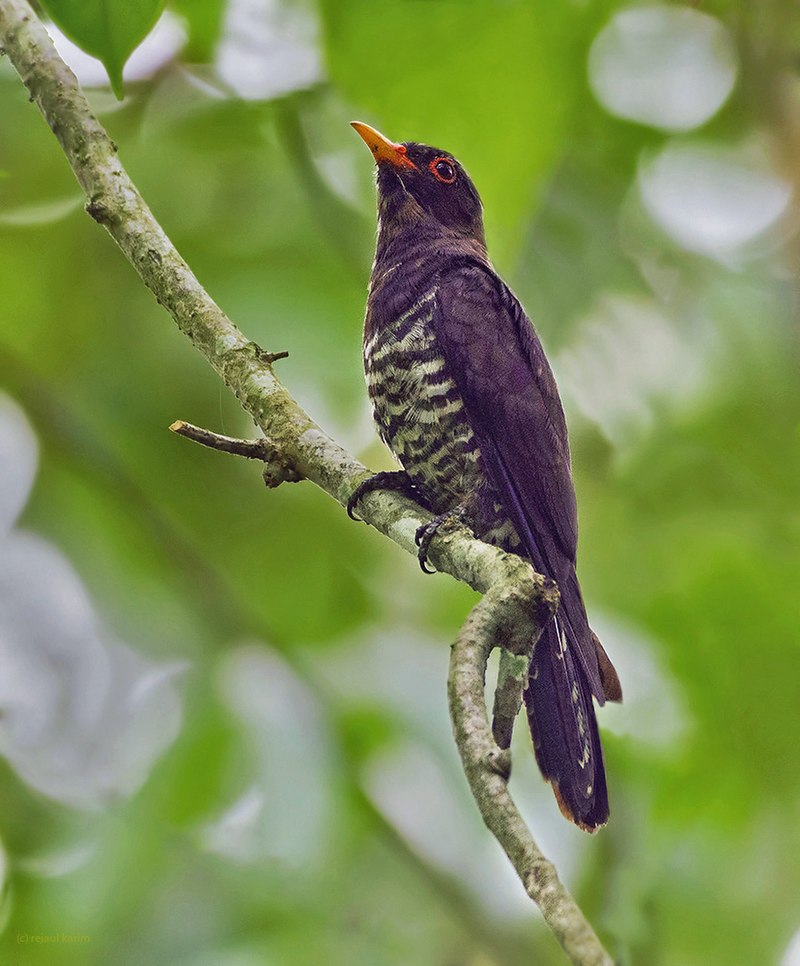
The Violet Cuckoo is a stunning bird with glossy violet feathers on its head and upper body. Its tail has a white tip and barred outer feathers, while the chin and upper breast are brightly iridescent.
The belly of the cuckoo is white with broad black, green or violet bars that contrast beautifully against its more vibrant plumage.
Adult males also have some reddish-brown patches around their throat area which adds to their alluring appearance.
These birds inhabit tropical forests throughout Southeast Asia where they feed mainly on insects, small lizards and fruits from trees such as figs, berries and mangos – making them quite popular amongst local wildlife.Scientific classification:
| Kingdom | Animalia |
| Phylum | Chordata |
| Class | Aves |
| Order | Cuculiformes |
| Family | Cuculidae |
| Genus | Chrysococcyx |
| Species | C. xanthorhynchus |
Also Featured In: Common Birds in India, Birds that You’ll Find in Kolkata
2. Dark-Necked Tailorbird
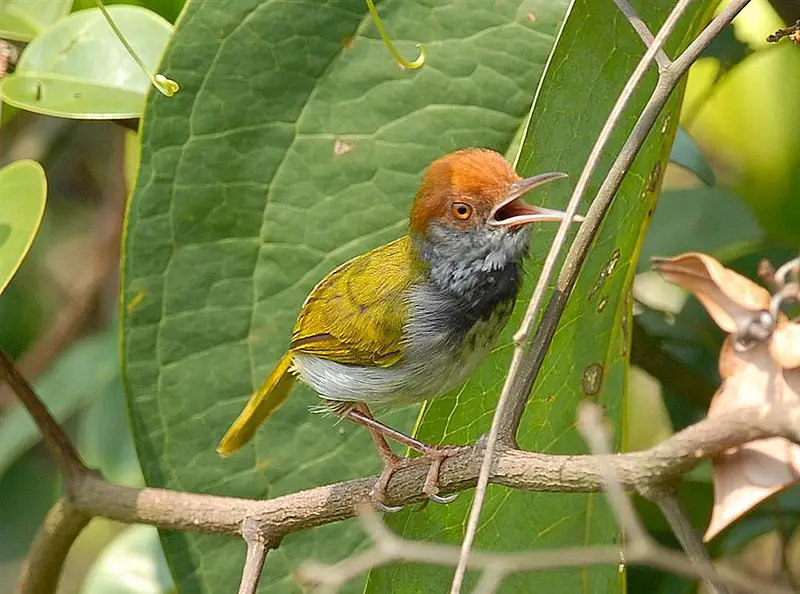
The Dark-necked Tailorbird is a small songbird species that belongs to the Cisticolidae family. It can be found in Bangladesh, Northeast India and Southeast Asia, where it inhabits subtropical or tropical moist lowland forests as well as mangrove forests.
This bird has an olive-brown upper body with dark streaks on its wings and tail while its underside is yellowish white with grey flanks.
The head of this species has distinct black stripes running from behind the eye down onto neck which gives it its name – “Dark-Necked”.
Its call sound like ‘dzeet’ and they are usually heard during morning hours when these birds sing in pairs or groups perched high up in trees.Scientific classification:
| Kingdom | Animalia |
| Phylum | Chordata |
| Class | Aves |
| Order | Passeriformes |
| Family | Cisticolidae |
| Genus | Orthotomus |
| Species | O. atrogularis |
Also Featured In: Most Common Types of Bangladeshi Birds,
3. Orange-Bellied Flowerpecker
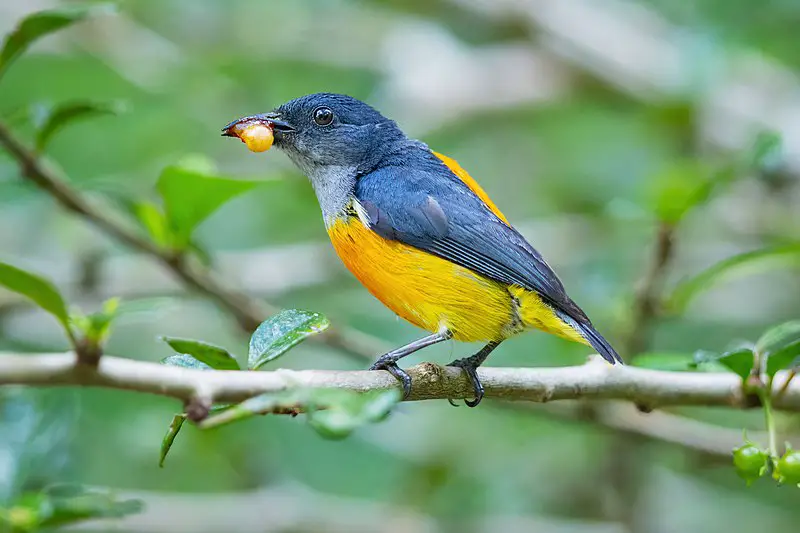
The orange-bellied flowerpecker is a small bird found in countries such as Bangladesh, Brunei, India and Thailand. It inhabits lowland forests, mangrove forests and montane forests.
Males of this species are quite distinctive with their bright orange bellies contrasting against the black head with white markings around the eyes.
They have green wings that feature yellow edging on the tips of their primaries and secondaries.
Their bill is short but stout for its size making it ideal for catching insects from branches or tree trunks during feeding sessions.
The female differs slightly in coloration having an olive crown instead of black one which makes them easier to identify when observed together within flocks or pairs .Scientific classification:
| Kingdom | Animalia |
| Phylum | Chordata |
| Class | Aves |
| Order | Passeriformes |
| Family | Dicaeidae |
| Genus | Dicaeum |
| Species | D. trigonostigma |
4. Pied Triller
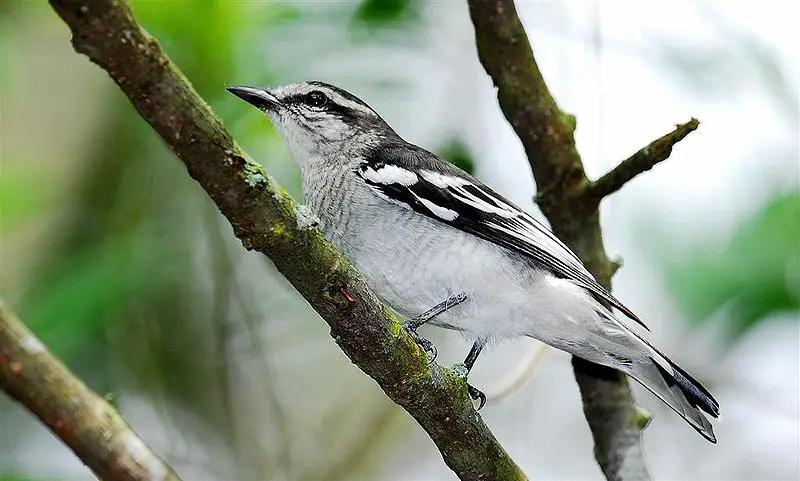
The Pied Triller is a species of bird found in parts of South East Asia. It belongs to the family Campephagidae and can be seen in Brunei, India, Indonesia, Malaysia, Philippines, Singapore and Thailand.
This black-and-white passerine has an eye patch that sets it apart from other birds its size. Its underparts are white with rufous upperparts and wings as well as grey crowns on both males and females giving them a unique look.
They mainly feed on insects but have also been observed eating fruits from trees or shrubs occasionally.
In terms of habitat they prefer forests but can adapt to secondary growth habitats too if needed for survival purposes making them quite adaptive creatures indeed.Scientific classification:
| Kingdom | Animalia |
| Phylum | Chordata |
| Class | Aves |
| Order | Passeriformes |
| Family | Campephagidae |
| Genus | Lalage |
| Species | L. nigra |
Also Featured In: Birds of the Philippines, Common Philippines Birds
5. Chestnut-Breasted Malkoha
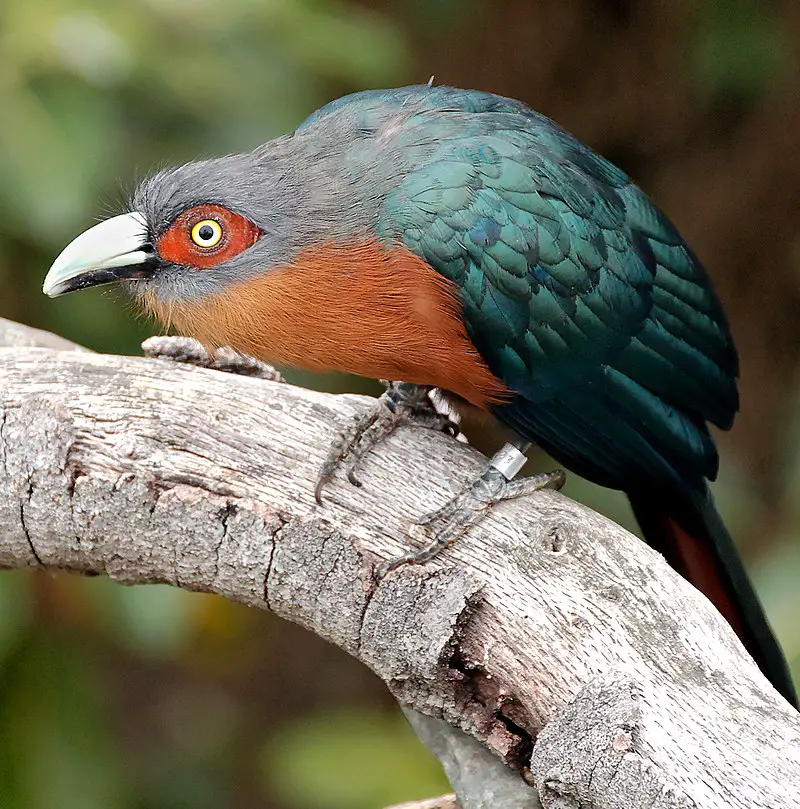
The Chestnut-breasted malkoha is a species of cuckoo found in Southeast Asia, ranging from Myanmar to eastern Java, the Philippines and Borneo.
It stands out among other birds with its large size – measuring up to 49 cm (19 inches) – and striking coloration: grey and dark green upperparts contrasted by chestnut underparts.
Males and females look alike, featuring curved pale upper mandibles. This bird does not exhibit typical cuckoo behaviour like egg laying; instead it eats mainly fruit but also hunts for insects on occasion.
The Chestnut-breasted malkoha is an impressive sight that brightens up any jungle or forest environment.Scientific classification:
| Kingdom | Animalia |
| Phylum | Chordata |
| Class | Aves |
| Order | Cuculiformes |
| Family | Cuculidae |
| Genus | Phaenicophaeus |
| Species | P. curvirostris |
6. Golden-Whiskered Barbet
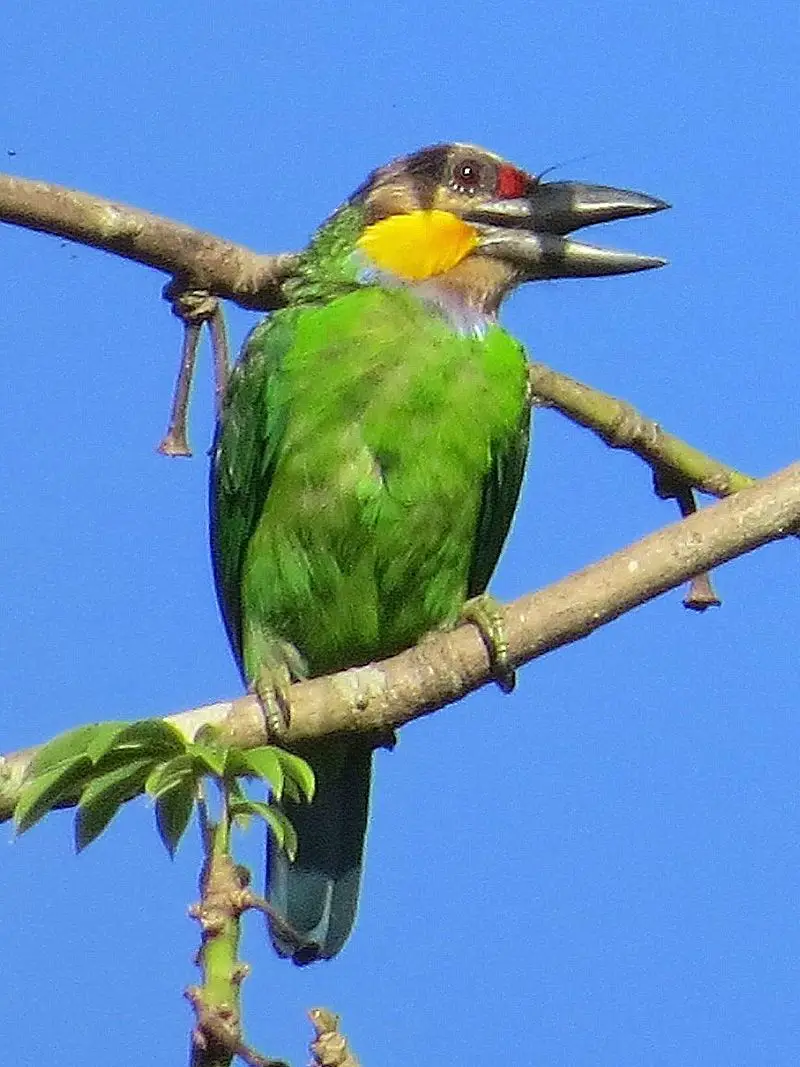
The Golden-whiskered Barbet is a captivating bird native to the western Malay Archipelago.
This species of barbet has vivid green plumage with hues ranging from yellowish-green to dark teal, and its most distinguishing feature is two golden tufts just above its black beak.
It resides mainly in forests up to 1,500 m (4,900 ft) elevation.
Despite it’s wide distribution range across Asia, this beautiful bird remains listed as Least Concern on the IUCN Red List due to its stable population size and lack of threats.
Its striking features make it one of nature’s greatest treasures.Scientific classification:
| Kingdom | Animalia |
| Phylum | Chordata |
| Class | Aves |
| Order | Piciformes |
| Family | Megalaimidae |
| Genus | Psilopogon |
| Species | P. chrysopogon |
Also Featured In: Beautiful Malaysian birds,
7. Hooded Pitta
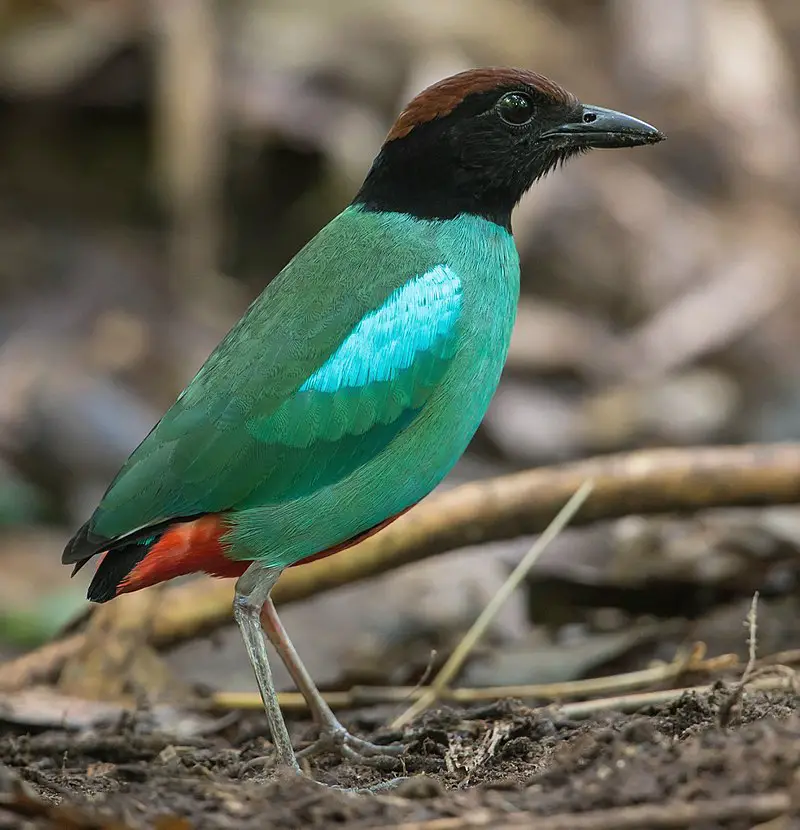
The Hooded Pitta is a beautiful and vibrant bird found in eastern and southeastern Asia, as well as maritime Southeast Asia. This small passerine has bright green feathers with a black head crowned by chestnut-colored plumage.
It feeds mainly on insects and their larvae but can also be seen eating berries from time to time.
During breeding season it inhabits forests of various types such as plantations or cultivated areas; these birds build ground nests usually near water sources so they can stay hydrated throughout the day.
The Hooded Pitta makes for an interesting sight to see out in nature.Scientific classification:
| Kingdom | Animalia |
| Phylum | Chordata |
| Class | Aves |
| Order | Passeriformes |
| Family | Pittidae |
| Genus | Pitta |
| Species | P. sordida |
8. Macronus Gularis
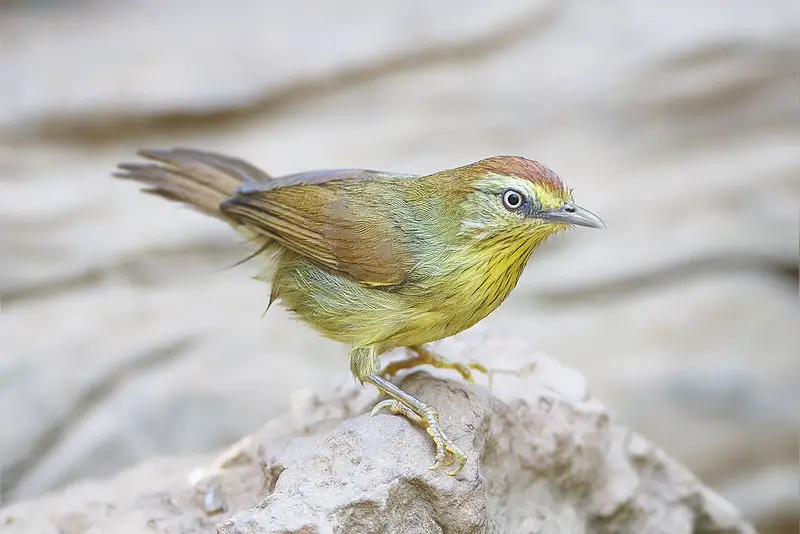
The Macronus gularis bird, commonly known as the Pin-Striped Tit-Babbler or Yellow-Breasted Babbler, is a species of Old World babbler found in South and Southeast Asia.
It was first described by American naturalist Thomas Horsfield in 1822 based on specimens collected from Sumatra.
The name ‘Macronus’ comes from the Greek words for “long” and “nose”, referring to its long beak.
They have brownish gray upperparts with paler underparts covered with bold black streaks along their sides and wings; they also have yellow throats which make them easily recognizable at a distance.
Macronus gularis are social birds that live in small groups of 3-10 individuals and communicate through loud calls such as chirps or trills but also use contact calls like whistles when separated from other members of their group.
Their diet consists mainly of insects, fruits, seeds, flowers buds – making them important pollinators.Scientific classification:
| Kingdom | Animalia |
| Phylum | Chordata |
| Class | Aves |
| Order | Passeriformes |
| Family | Timaliidae |
| Genus | Mixornis |
| Species | M. gularis |
Also Featured In: Common Birds Found in Nepal, Most Common Tripura Birds You Need to Know
9. Black-Crested Bulbul
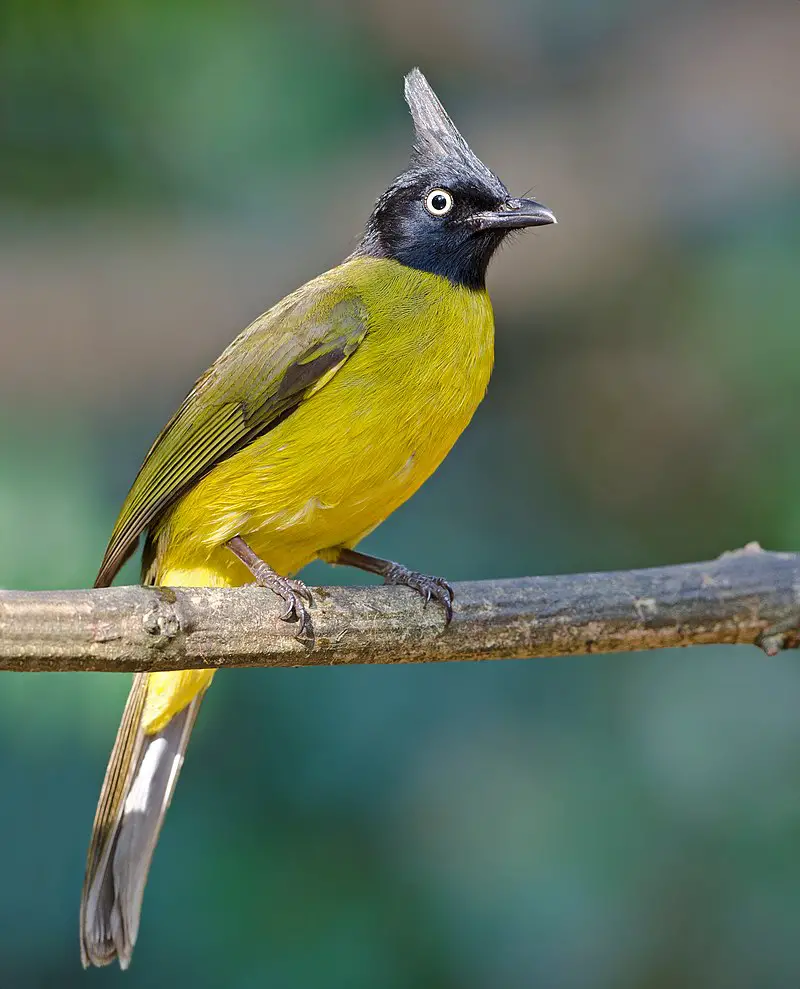
The Black-crested bulbul is a passerine bird belonging to the Bulbul Family. It can be found in India, Southeast Asia and other parts of the Indian subcontinent.
This species was first described under genus Vanga but later moved to Pycnonotus. However recent studies have revealed that this genus is polyphyletic leading five bulbuls including black-creasted ones to be placed in different genera.
The adult has an entirely black plumage with yellowish ventral side while juveniles are brownish grey above and whitish below having some pale streaks on their backsides as well.
Its diet consists mainly of fruits, insects and flower nectar which it feeds upon foraging among foliage or perching atop trees nearby water bodies like pools and streamsScientific classification:
| Kingdom | Animalia |
| Phylum | Chordata |
| Class | Aves |
| Order | Passeriformes |
| Family | Pycnonotidae |
| Genus | Rubigula |
| Species | R. flaviventris |
Also Featured In: Birds of Khao Yai National Park, Birds Live In Koh Kood
10. Bar-Winged Flycatcher-Shrike
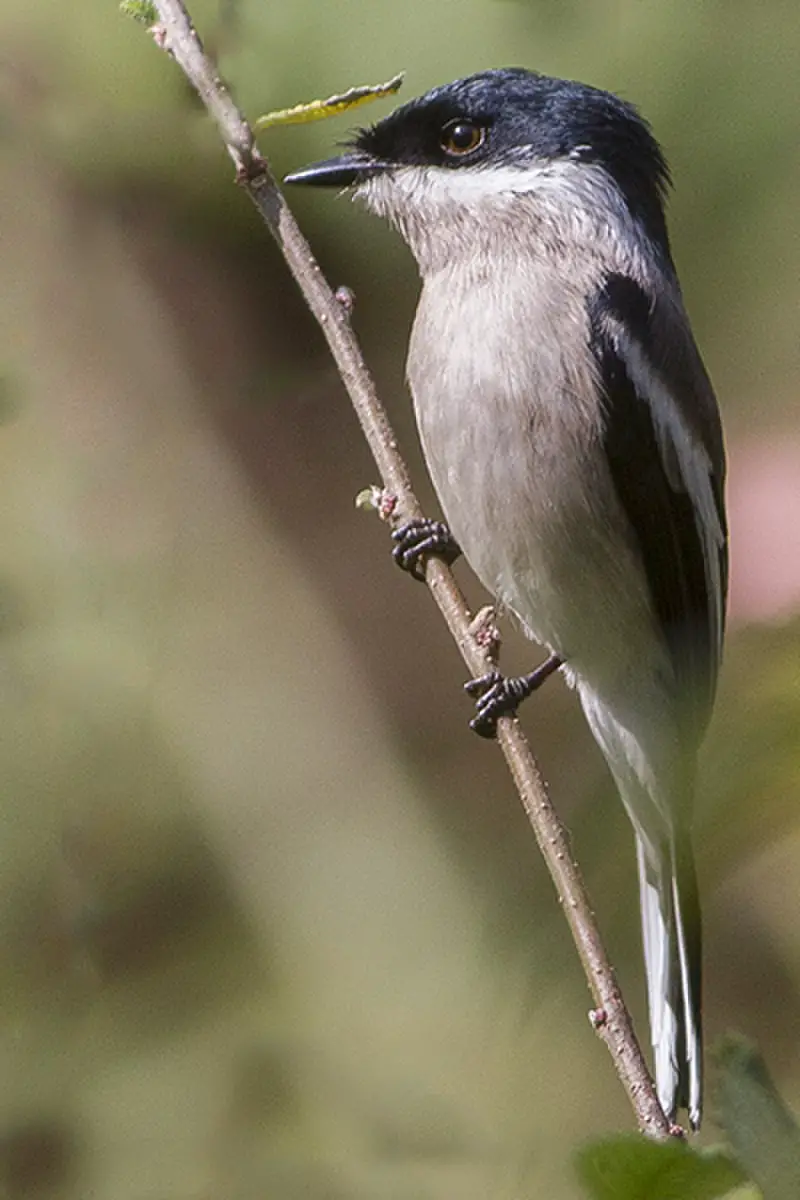
The Bar-winged Flycatcher-Shrike is a small passerine bird found in the forests of tropical southern Asia, ranging from the Himalayas and hills of India to Indonesia.
These birds inhabit mid-canopy levels in the forest, often joining mixed species flocks while they search for food.
With its distinctive pattern of black and white plumage on its head and wings, this flycatcher can be easily identified by experienced bird watchers.
They are mainly insectivorous birds that feed upon insects such as moths, beetles and flies which they capture using their sharp bill or talons during flight.
The bar-winged flycatcher has adapted well to life in these woodlands with an agile nature allowing it to navigate quickly through dense foliage when searching for prey or evading predators.Scientific classification:
| Kingdom | Animalia |
| Phylum | Chordata |
| Class | Aves |
| Order | Passeriformes |
| Family | Vangidae |
| Genus | Hemipus |
| Species | H. picatus |
Also Featured In: Birds of Goa, Common Birds that Live in Odisha
11. Slaty-Breasted Rail
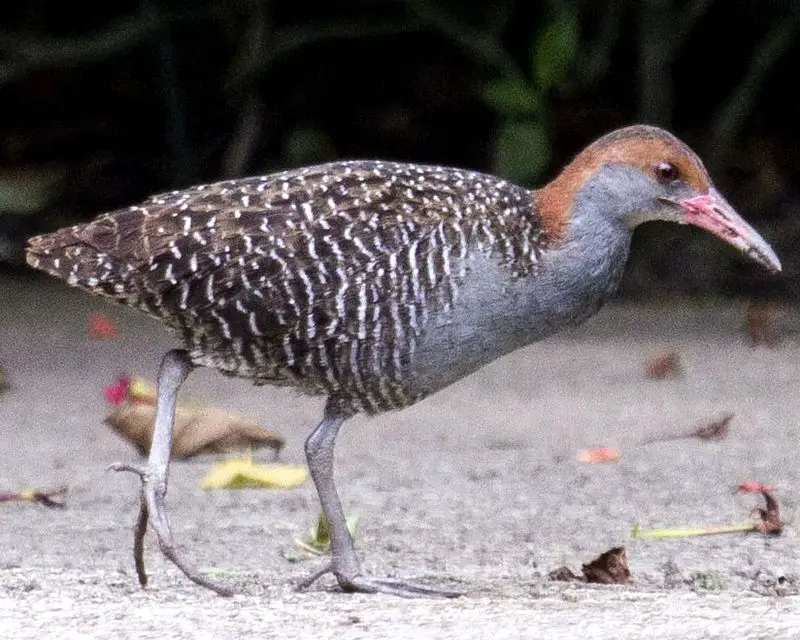
The Slaty-breasted Rail is a bird native to the Indian Subcontinent and Southeast Asia. During breeding season, they can be found near Dehradun in the foothills of India’s Himalayas.
This species has been placed in its own genus Lewinia due to new genetic studies which have now been accepted by the IUCN.
The plumage of this rail consists mainly of slaty grey with some black barring on its wings and tail feathers as well as vibrant chestnut flanks and belly.
It prefers habitats such as wetlands, muddy tidal flats or open grasslands for foraging where it searches for worms, insects and crustaceans among vegetation or mudflats respectively.
Despite being uncommon throughout much of their range these birds are not yet considered threatened – though further research into population numbers is necessary before we can fully understand their conservation status today.Scientific classification:
| Kingdom | Animalia |
| Phylum | Chordata |
| Class | Aves |
| Order | Gruiformes |
| Family | Rallidae |
| Genus | Lewinia |
| Species | L. striata |
Also Featured In: Singapore Birds, Common Birds of Maharashtra
12. Blue-Winged Pitta
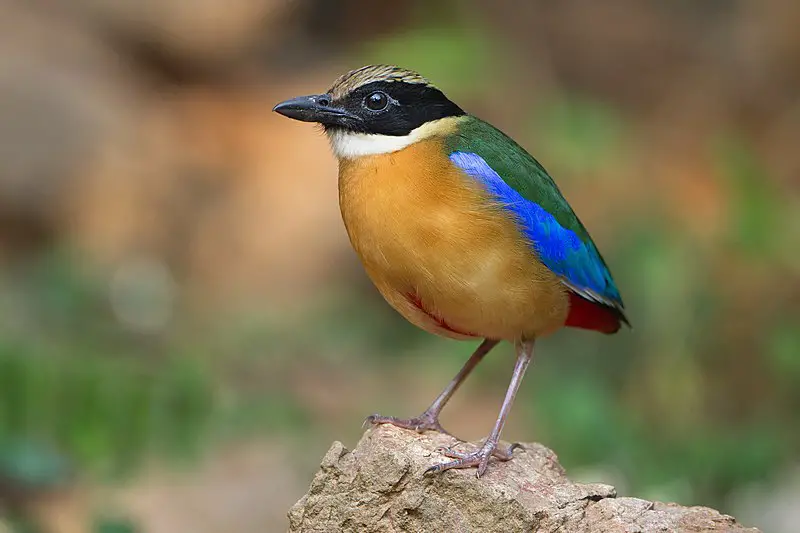
The Blue-winged pitta is a stunningly beautiful passerine bird in the family Pittidae. It has an unmistakable appearance, with its black head and white collar contrasting against its greenish upper parts and blue wings.
Its buff underparts blend into a reddish vent area that adds to the vividness of this species.
This colourful beauty forms part of a larger group known as superspecies which includes three other pittas; Indian, fairy and mangrove varieties respectively.
They can be found in tropical forests across South East Asia where they feed on insects amongst lush foliage or along waterways.
Despite their striking colouration these birds are cryptically coloured making them difficult to spot by predators such as snakes, lizards or cats.Scientific classification:
| Kingdom | Animalia |
| Phylum | Chordata |
| Class | Aves |
| Order | Passeriformes |
| Family | Pittidae |
| Genus | Pitta |
| Species | P. moluccensis |
13. Asian Red-Eyed Bulbul
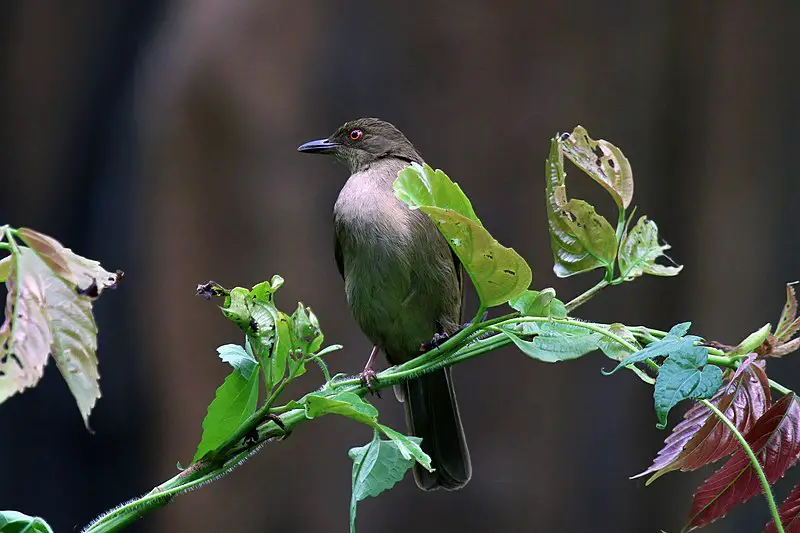
The Asian red-eyed bulbul is a passerine bird belonging to the bulbul family. It has an expansive range, inhabiting lowland forests in Malaysia, Sumatra and Borneo.
This species can be identified by its distinctive chestnut brown plumage, bright red eyes and black forehead crest.
They are somewhat similar in appearance to other bulbuls but have a different call which consists of short chirps interspersed with whistles.
These birds form small flocks when foraging for food such as fruits or insects on the ground or high up in trees and shrubs.
Though they prefer living in dense vegetation near water sources, they may also be found around human habitations where there are plenty of food sources available year-round such as gardens and farms.
The Asian Red-Eyed Bulbuls’ diet includes berries, seeds grains invertebrates like crickets & grasshoppers making them beneficial garden visitors.Scientific classification:
| Kingdom | Animalia |
| Phylum | Chordata |
| Class | Aves |
| Order | Passeriformes |
| Family | Pycnonotidae |
| Genus | Pycnonotus |
| Species | P. brunneus |
Also Featured In: Brunei birds,
14. Hemicircus Sordidus
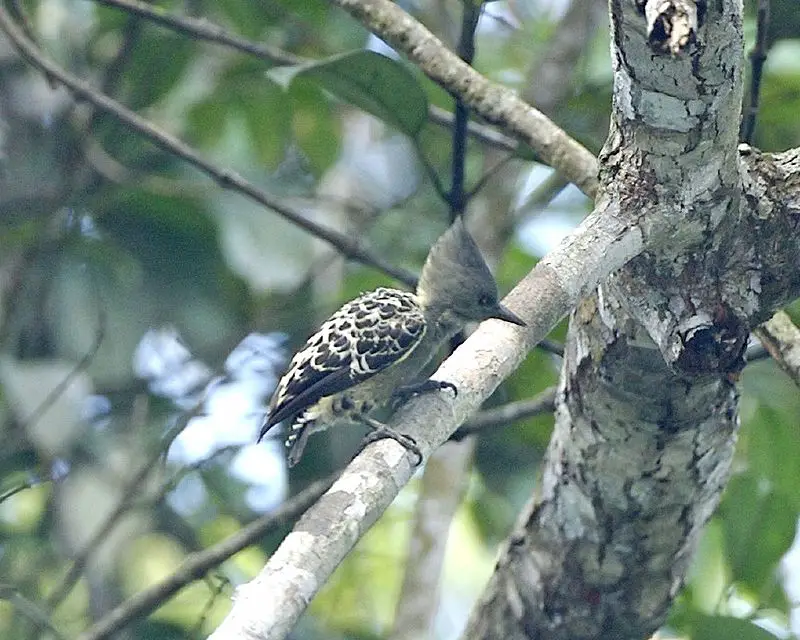
The grey-and-buff woodpecker, scientifically known as Hemicircus concretus, is a species of bird belonging to the family Picidae.
It inhabits areas in Brunei, Indonesia (Sumatra and Borneo), Malaysia, southern Myanmar and Southern Thailand.
Unfortunately this beautiful bird has become regionally extinct in Singapore due to habitat loss and degradation.
This species prefers living in lowland or montane tropical or subtropical moist broadleaf forests for its natural habitats.
The formal description of the grey-and-buff woodpecker was made by German ornithologist Jean Cabanis who named it after its distinctive colors – grey body with buff wings & tail feathers which make it look distinct from other birds in its range.
Conservation efforts are being carried out to protect this endangered species so that they can continue thriving across their native ranges without facing extinction like many others did before them.Scientific classification:
| Kingdom | Animalia |
| Phylum | Chordata |
| Class | Aves |
| Order | Piciformes |
| Family | Picidae |
| Genus | Hemicircus |
| Species | H. concretus |
Also Featured In: Woodpeckers Species,
15. Asian Fairy-Bluebird
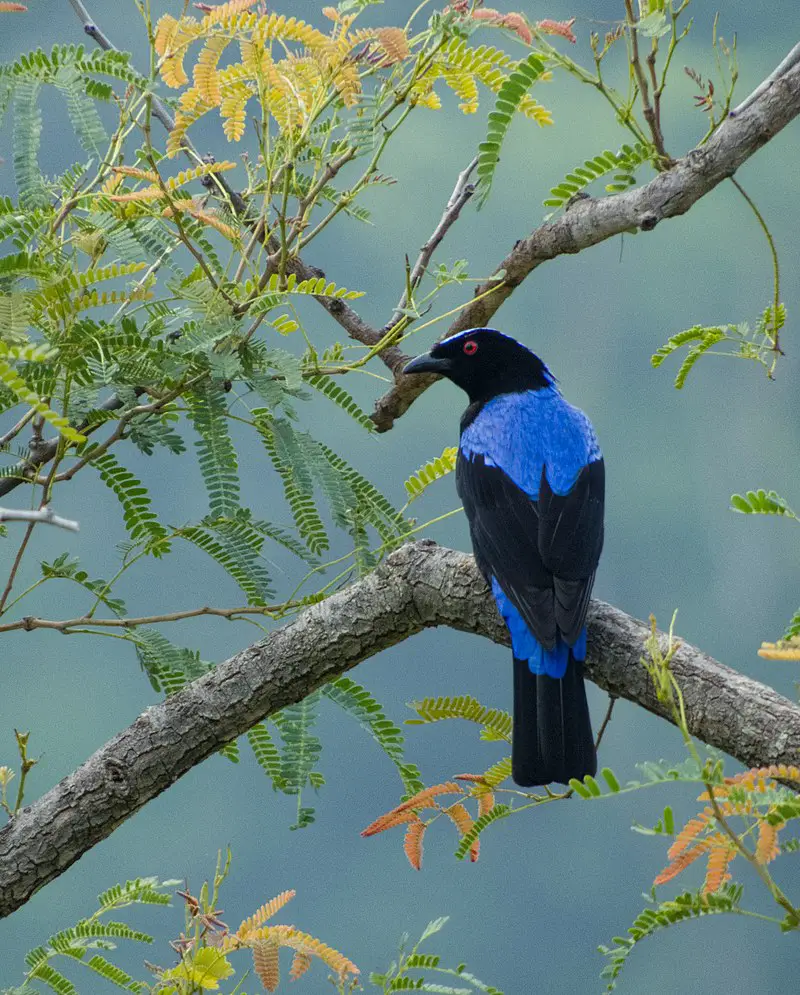
The Asian fairy-bluebird is a beautiful medium-sized bird found in the tropical forests of Southern Asia, Indochina, and the Greater Sundas.
Known for its stunning blue and black plumage, this arboreal passerine bird is a treat for birdwatchers to spot.
The female lays two or three eggs in a small cup nest in a tree, and both parents take turns incubating them.
British ornithologist John Latham described this bird in 1790, and it is the only other member of its genus and family besides the Philippine fairy-bluebird.
Though not much is known about their specific numbers, their populations appear to be stable, making them a delight for future generations to observe as well.Scientific classification:
| Kingdom | Animalia |
| Phylum | Chordata |
| Class | Aves |
| Order | Passeriformes |
| Family | Irenidae |
| Genus | Irena |
| Species | I. puella |
Also Featured In: Common Birds in Kerala,
16. Whiskered Treeswift
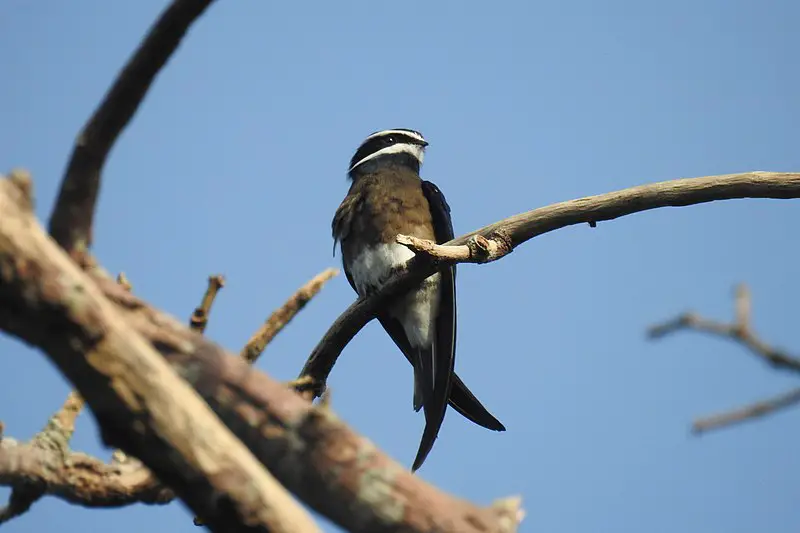
The Whiskered treeswift is a small bird belonging to the Hemiprocnidae family. It is one of the four species in the Hemiprocne genus, and it can be found in Brunei, Indonesia, Malaysia, Myanmar, the Philippines, Singapore, and Thailand.
This species inhabits subtropical or tropical moist lowland forest, mangrove forest, and moist montane forests.
The bird’s whiskers give it an interesting look, hence its name. Though small, the Whiskered treeswift is an adept aerial hunter, darting through the trees in search of insects.
Its small size also allows it to fly quickly and maneuver easily in tight spaces. This bird is considered to be of least concern when it comes to conservation status, as its population is thought to be stable.Scientific classification:
| Kingdom | Animalia |
| Phylum | Chordata |
| Class | Aves |
| Clade | Strisores |
| Order | Apodiformes |
| Family | Hemiprocnidae |
| Genus | Hemiprocne |
| Species | H. comata |
Also Featured In: Birds that Live in Borneo Island, Most Common Birds in Negros
17. Brown-Throated Sunbird
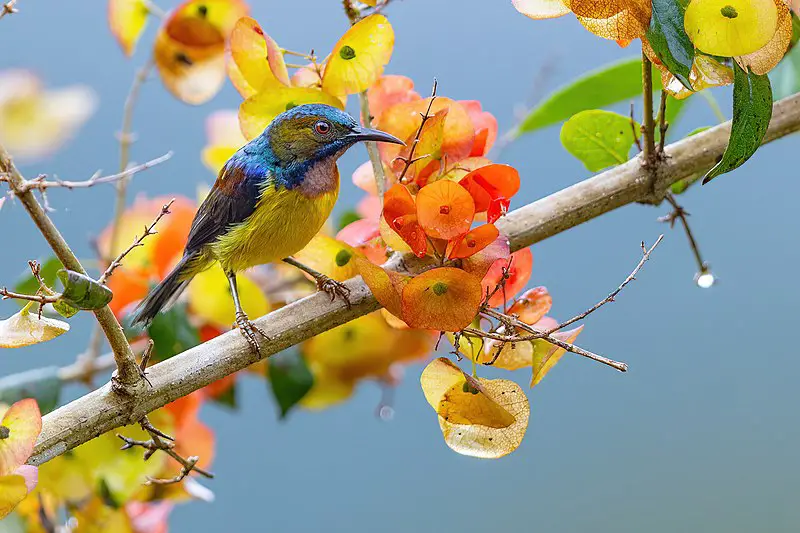
The brown-throated sunbird, also known as the plain-throated sunbird, is a small bird that belongs to the family Nectariniidae.
Commonly found in south-east Asia, it inhabits a variety of semi-open habitats, from Myanmar to the Lesser Sundas and west Philippines.
This species is recognized by its brownish plumage and distinctive brown throat, which differentiates it from the grey-throated sunbird species found in the Philippines.
The brown-throated sunbird has a slender beak that allows it to feed on nectar from flowers and insects.
It is known for its acrobatic flight and can often be seen flitting rapidly between flowers in search of food.
These birds are essential pollinators for many plant species, making them an important contributor to the ecosystems in which they live.Scientific classification:
| Kingdom | Animalia |
| Phylum | Chordata |
| Class | Aves |
| Order | Passeriformes |
| Family | Nectariniidae |
| Genus | Anthreptes |
| Species | A. malacensis |
Also Featured In: Birds that Commonly Found in Bali, HDB Approved by Birds
18. Grey-Rumped Treeswift
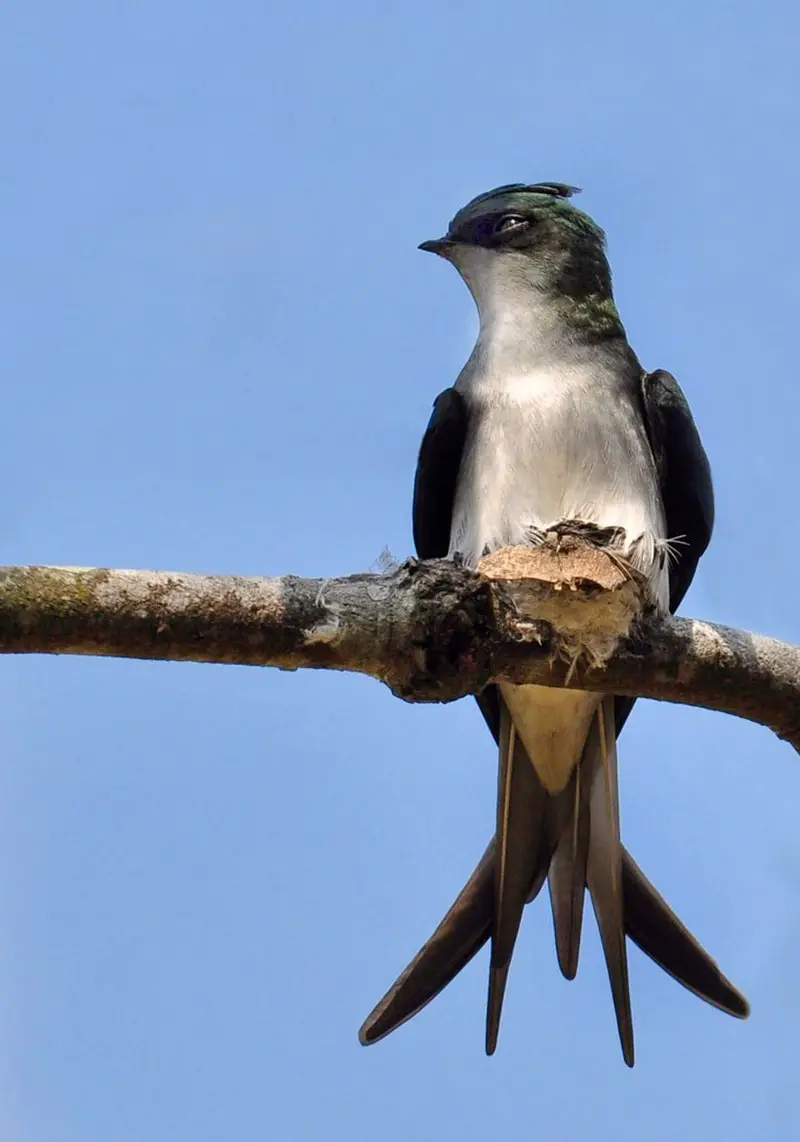
The Grey-rumped treeswift is a type of bird belonging to the Hemiprocnidae family. It is closely related to true swifts, but is different in that it prefers an arboreal lifestyle, perching on trees and power lines.
Unlike other swifts, the Grey-rumped treeswift has a distinct grey coloring on its rear end. It is one of only four species in the Hemiprocnidae family. This bird is often seen on pylons and high-tension power transmission lines.
Despite its name, the Grey-rumped treeswift is not actually related to the common swift. It has a unique physiology and behavior that sets it apart from other avian species.
The Grey-rumped treeswift is a fascinating bird that birdwatchers and nature enthusiasts alike should look out for.Scientific classification:
| Kingdom | Animalia |
| Phylum | Chordata |
| Class | Aves |
| Clade | Strisores |
| Order | Apodiformes |
| Family | Hemiprocnidae |
| Genus | Hemiprocne |
| Species | H. longipennis |
Also Featured In: Common Birds of Lombok,
19. Yellow-Rumped Flycatcher
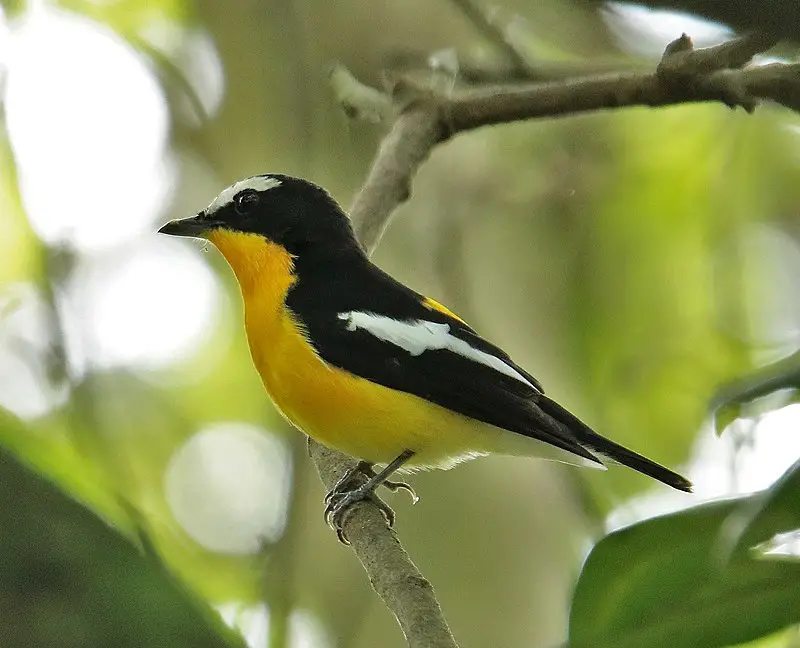
The Yellow-rumped Flycatcher is a unique and distinguishable bird primarily found in eastern Asia. Along with the narcissus flycatcher, it is almost impossible to mistake with other species.
These birds breed in regions such as Mongolia, southern China, Korea, Transbaikal, and western Japan.
In the winter, they migrate towards the Malay Peninsula. Their most noticeable feature is their bright yellow rump, which contrasts sharply with their dark coloration.
They are also known as Korean Flycatchers or Tricolor Flycatchers. Habitually, they prefer to perch on low branches and fly to catch insects on the wing.
These birds are known to breed in forests and heavily wooded areas, in addition to residential gardens and parks.
Though their range is relatively large, they are not considered to be threatened or endangered at this point in time.Scientific classification:
| Kingdom | Animalia |
| Phylum | Chordata |
| Class | Aves |
| Order | Passeriformes |
| Family | Muscicapidae |
| Genus | Ficedula |
| Species | F. zanthopygia |
20. Rufous-Tailed Tailorbird
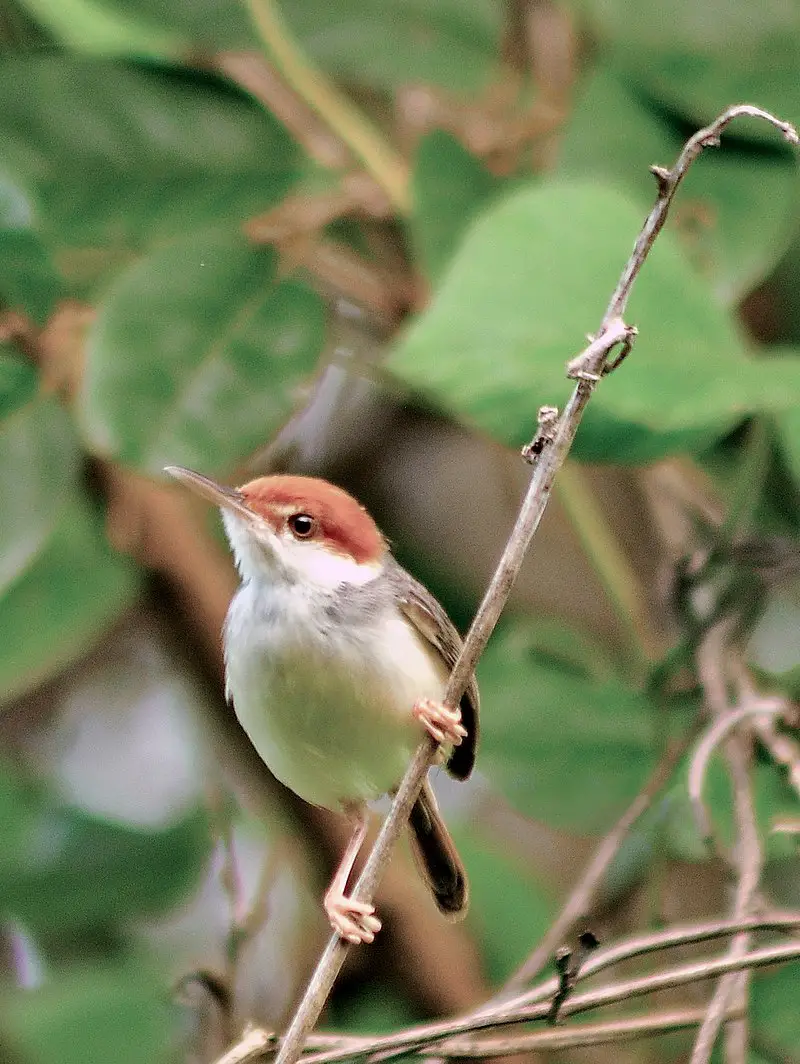
The Rufous-tailed tailorbird is a small bird that is found in various Southeast Asian countries. It was previously considered as part of the Old World warbler’s family but is now classified under the Cisticolidae family.
This bird species typically resides in lowland forests with a subtropical or tropical climate, including mangrove forests.
The Rufous-tailed tailorbird’s long, rufous-colored tail feathers are its distinctive feature. They are expert weavers and possess the unique ability to stitch leaves together to create their homes.
These birds have a varied vocal range, and their calls are often used to communicate with their partners.
They also feed on insects and other small creatures found in their habitat. The Rufous-tailed tailorbird is a beautiful bird that adds charm to the Southeast Asian forests it inhabits.Scientific classification:
| Kingdom | Animalia |
| Phylum | Chordata |
| Class | Aves |
| Order | Passeriformes |
| Family | Cisticolidae |
| Genus | Orthotomus |
| Species | O. sericeus |
Also Featured In: Birds that Found in Sumatra, Palawan Island Birds
21. Raffles’s Malkoha
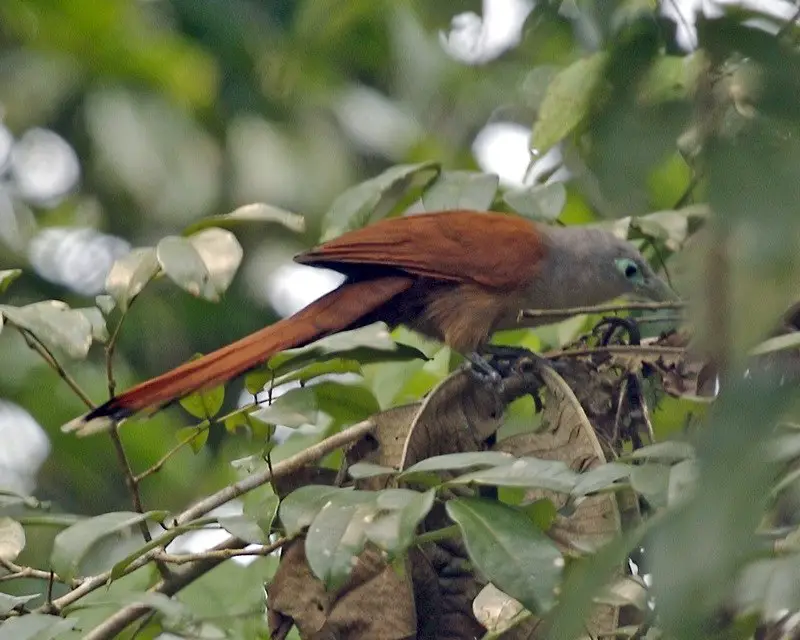
The Raffles’s malkoha is a unique species of cuckoo with distinct characteristics not found in its presumed relatives. Unlike other malkohas, it exhibits sexual dimorphism and possesses several autapomorphies, which sets it apart.
Although it was previously grouped with other malkohas in Phaenicophaeus, it is believed that it may belong to a very basal lineage of cuckoos instead.
The exact classification of the Raffles’s malkoha is still being studied and understood by experts.
Despite this, it remains a fascinating bird with beautiful plumage that can be found in parts of Southeast Asia.Scientific classification:
| Kingdom | Animalia |
| Phylum | Chordata |
| Class | Aves |
| Order | Cuculiformes |
| Family | Cuculidae |
| Genus | Rhinortha Vigors, 1830 |
| Species | R. chlorophaea |
22. Black-Bellied Malkoha
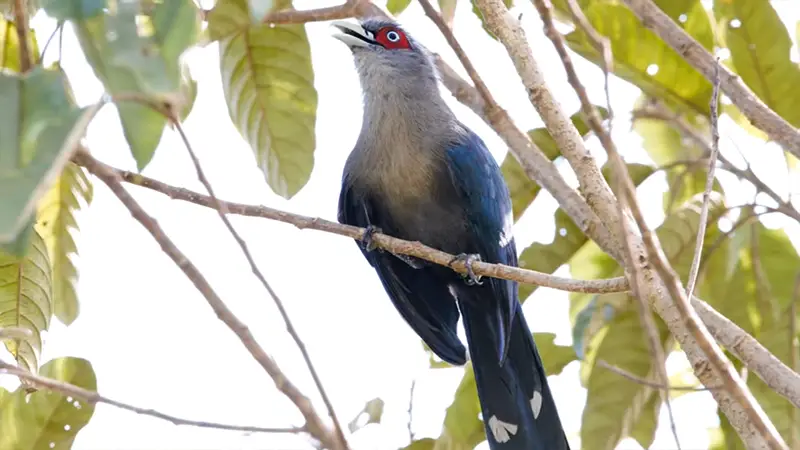
The Black-bellied malkoha is a species of bird belonging to the family Cuculidae. It is native to Brunei, Indonesia, Malaysia, Myanmar, Singapore, and Thailand.
This bird species loves to dwell in subtropical, tropical moist lowland forests, and mangrove forests. The Black-bellied malkoha is in danger due to habitat loss.Scientific classification:
| Kingdom | Animalia |
| Phylum | Chordata |
| Class | Aves |
| Order | Cuculiformes |
| Family | Cuculidae |
| Genus | Phaenicophaeus |
| Species | P. diardi |
23. Chestnut-Bellied Malkoha
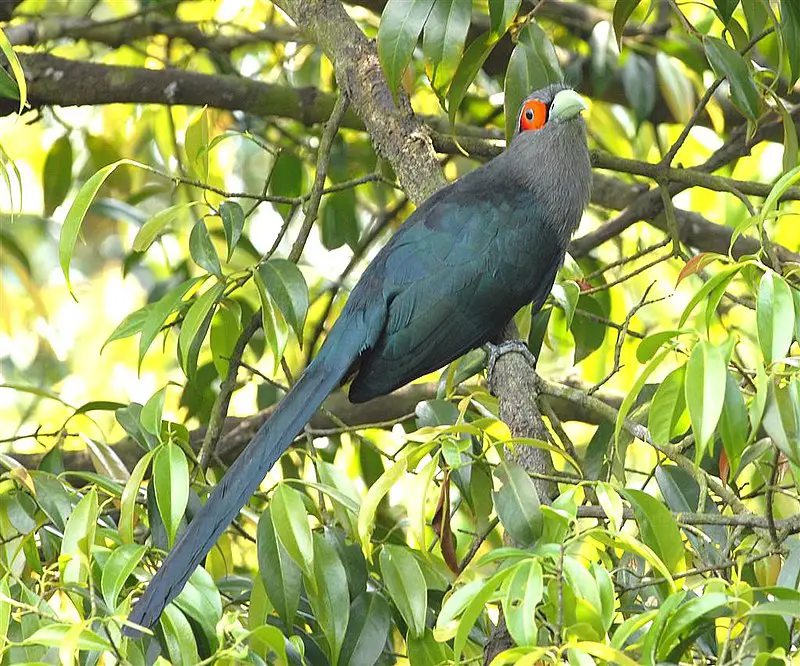
The chestnut-bellied malkoha is a cuckoo bird found in Southeast Asia. It inhabits subtropical or tropical forests, mangrove areas, and swamplands, however, it faces a threat due to habitat loss.
This bird species is known for its distinctive chestnut-colored belly and can be found in countries including Brunei, Indonesia, Malaysia, Myanmar, Singapore, and Thailand.
As a member of the cuckoo family, the chestnut-bellied malkoha exhibits parasitic breeding behavior, laying its eggs in the nests of other bird species.
However, it also contributes to the ecosystem by helping to control insect populations.
Overall, conservation efforts are needed to protect the chestnut-bellied malkoha and its habitat.Scientific classification:
| Kingdom | Animalia |
| Phylum | Chordata |
| Class | Aves |
| Order | Cuculiformes |
| Family | Cuculidae |
| Genus | Phaenicophaeus |
| Species | P. sumatranus |
24. Stripe-Throated Bulbul
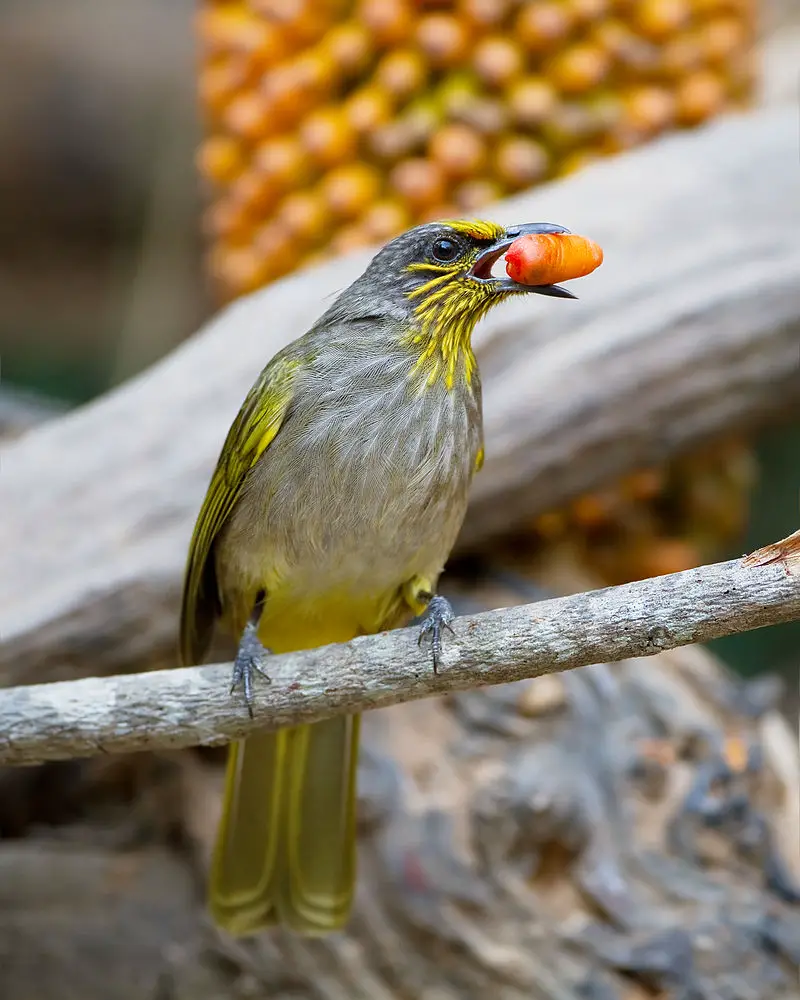
The stripe-throated bulbul bird is a passerine bird found in south-eastern Asia. Its natural habitats are tropical lowland and montane forests.
It is a common species and is not considered endangered by the International Union for Conservation of Nature.
The bird has a distinct stripe on its throat and is also known as the streak-throated bulbul. As a songbird, it is known for its melodious calls.
The stripe-throated bulbul is an active bird, often found in pairs or small groups. It is an omnivore, feeding on fruits, insects, and other small invertebrates.
The bird is an important indicator species for the overall health of its forest habitat.Scientific classification:
| Kingdom | Animalia |
| Phylum | Chordata |
| Class | Aves |
| Order | Passeriformes |
| Family | Pycnonotidae |
| Genus | Pycnonotus |
| Species | P. finlaysoni |
25. Cream-Vented Bulbul
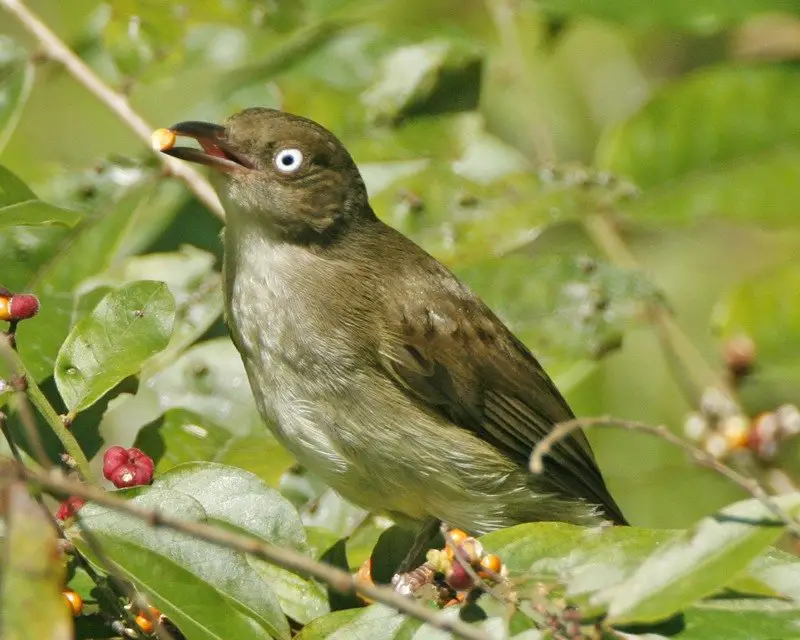
The cream-vented bulbul is a passerine bird found in south-eastern Asia. It inhabits subtropical or tropical moist lowland forests.
Also known as the white-eyed brown bulbul or white-eyed bulbul, it has a distinctive cream-colored vent and may have a yellow breast.Scientific classification:
| Kingdom | Animalia |
| Phylum | Chordata |
| Class | Aves |
| Order | Passeriformes |
| Family | Pycnonotidae |
| Genus | Pycnonotus |
| Species | P. simplex |
26. Scaly-Breasted Bulbul
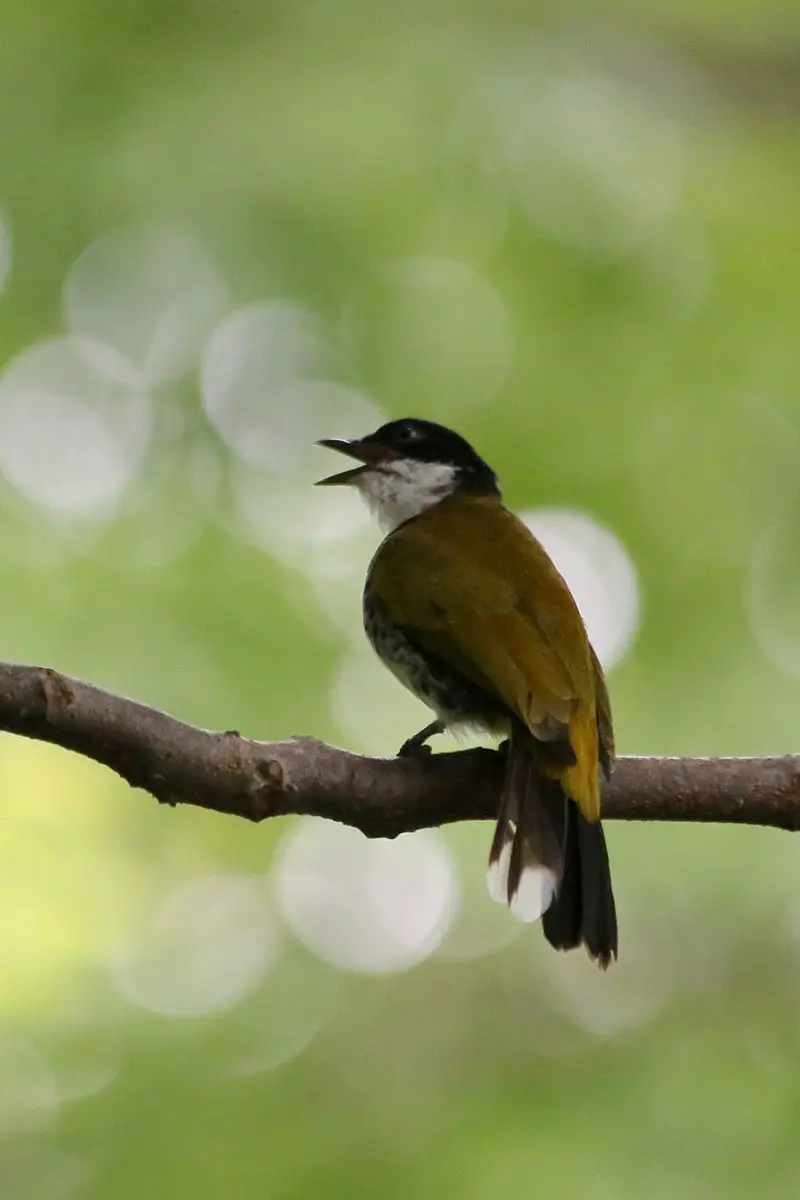
The Scaly-breasted bulbul is a small songbird that inhabits subtropical or tropical moist lowland forests across the Malay Peninsula to Borneo. This species was initially classified under the genus Ixos, but later moved to Pycnonotus.
Unfortunately, habitat loss is now threatening the survival of the Scaly-breasted bulbul. These birds have unique scales on their breasts, which is how they got their name. They are popular among bird-watching enthusiasts because of their melodious song.
They are known to live in small groups and feed on fruits, insects, and nectar. It is important to preserve the habitat of the Scaly-breasted bulbul to ensure that this beautiful species does not become endangered.Scientific classification:
| Kingdom | Animalia |
| Phylum | Chordata |
| Class | Aves |
| Order | Passeriformes |
| Family | Pycnonotidae |
| Genus | Ixodia |
| Species | I. squamata |
27. Plain Sunbird
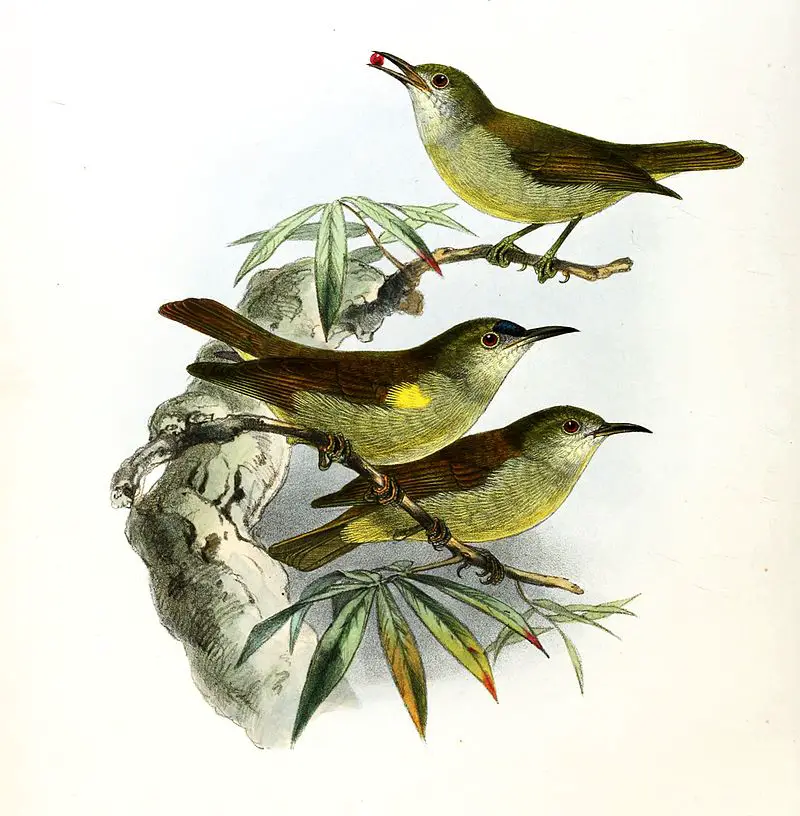
The Plain sunbird is a bird species that belongs to the Nectariniidae family. This bird can be found in Southeast Asian countries such as Brunei, Indonesia, Malaysia, Myanmar, Singapore, and Thailand.
It thrives in subtropical or tropical moist lowland forests as well as mangrove forests.
The Plain sunbird is a small bird with a plain appearance, hence its name. As a nectar feeder, it plays a crucial role in the pollination of plants in its habitat.
This bird species has several distinct subspecies, with minor differences in their plumage and distribution.
The conservation status of the Plain sunbird is currently classified as Least Concern, although its population may be declining due to habitat loss and degradation.
Overall, the Plain sunbird is an important and fascinating member of Southeast Asia’s avifauna.Scientific classification:
| Kingdom | Animalia |
| Phylum | Chordata |
| Class | Aves |
| Order | Passeriformes |
| Family | Nectariniidae |
| Genus | Anthreptes |
| Species | A. simplex |
28. Ruby-Cheeked Sunbird
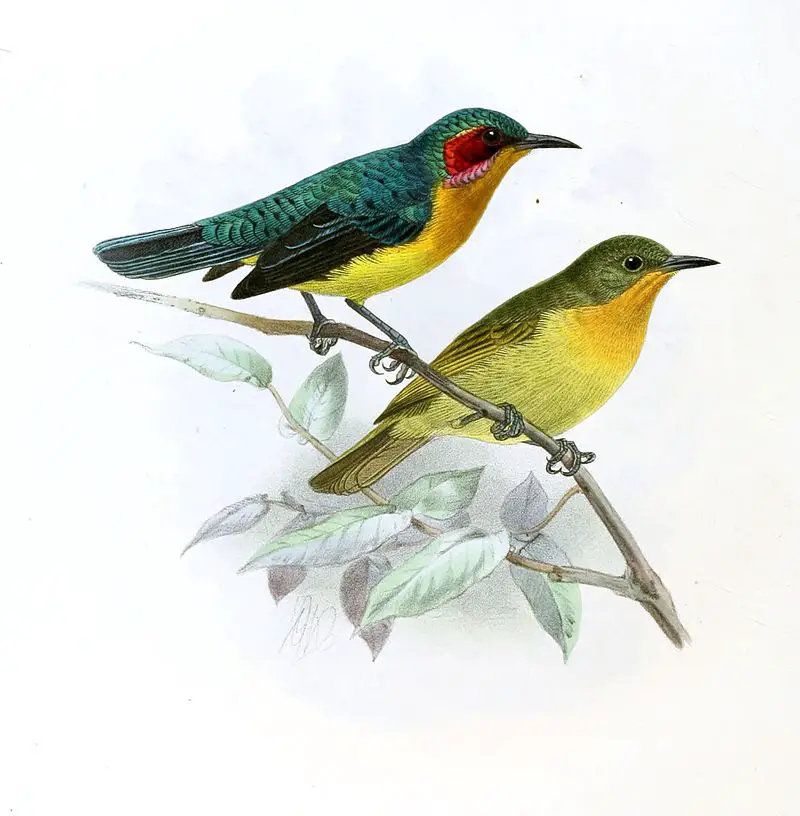
The Ruby-cheeked sunbird bird belongs to the Nectariniidae family and is native to numerous Asian countries.
It can be found in diverse habitats ranging from lowland forest to montane forest, including mangrove forests.
This tiny bird, with its vibrant plumage, has a ruby-red patch on its cheek. It is known for its ability to hover whilst feeding on nectar from flowers, aided by its long, curved bill.
Their diet mainly comprises nectar and small insects, and both sexes are involved in building their dome-shaped nests, made of woven plant material.
The Ruby-cheeked sunbird is a well-known songbird and its high-pitched chirps are a common sound in its natural habitats.
These birds play an essential role in pollination and are essential for the survival of numerous plant species.Scientific classification:
| Kingdom | Animalia |
| Phylum | Chordata |
| Class | Aves |
| Order | Passeriformes |
| Family | Nectariniidae |
| Genus | Chalcoparia Cabanis, 1850 |
| Species | C. singalensis |
Also Featured In: Birds You’ll find in Pulau Ubin Island,
29. Yellow-Eared Spiderhunter
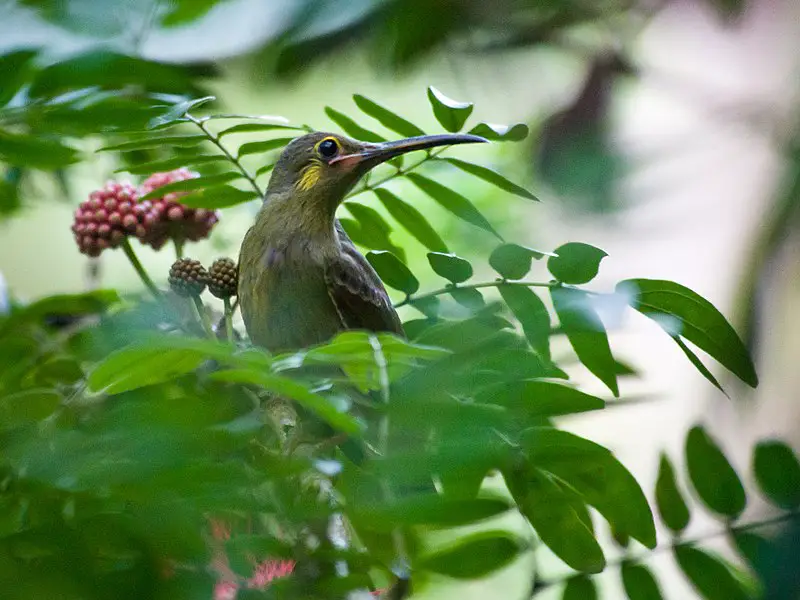
The yellow-eared spiderhunter is a bird in the family Nectariniidae, found in Brunei, Indonesia, Malaysia, Myanmar, Singapore, Thailand, and Vietnam.
It inhabits subtropical or tropical lowland forests, mangrove forests, and moist montane forests.
This species is easily distinguishable by its bright yellow ear patches. They have long, curved bills which allow them to feed on nectar from flowers.
The males have a greenish upper body and black underparts, while the females are duller in color and lack the black underparts.
They are active during the day and frequently visit flowers to feed.
The yellow-eared spiderhunter contributes to pollination of various plants in their habitats. They are not considered to be endangered at present.Scientific classification:
| Kingdom | Animalia |
| Phylum | Chordata |
| Class | Aves |
| Order | Passeriformes |
| Family | Nectariniidae |
| Genus | Arachnothera |
| Species | A. chrysogenys |
30. Lesser Green Leafbird
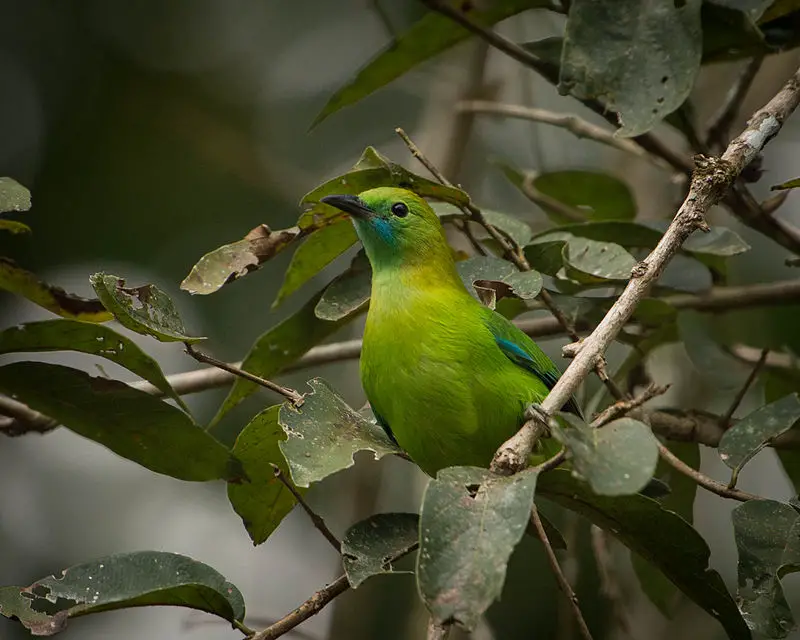
The Lesser green leafbird is a bird species belonging to the Chloropseidae family. This bird can be found in various countries such as Thailand, Myanmar, and Brunei.
Its natural habitat includes subtropical or tropical forests with moist lowland areas. Unfortunately, the Lesser green leafbird is now facing a significant threat due to the loss of its habitat.
This bird species’ striking green color makes it distinct from other birds. The Lesser green leafbird is a small bird and feeds on insects and fruits. Within its range, this bird is considered to be vulnerable due to the loss of forest habitat.
Therefore, conservation efforts should be implemented to protect this beautiful bird species from further decline.Scientific classification:
| Kingdom | Animalia |
| Phylum | Chordata |
| Class | Aves |
| Order | Passeriformes |
| Family | Chloropseidae |
| Genus | Chloropsis |
| Species | C. cyanopogon |
31. Yellow-Vented Flowerpecker
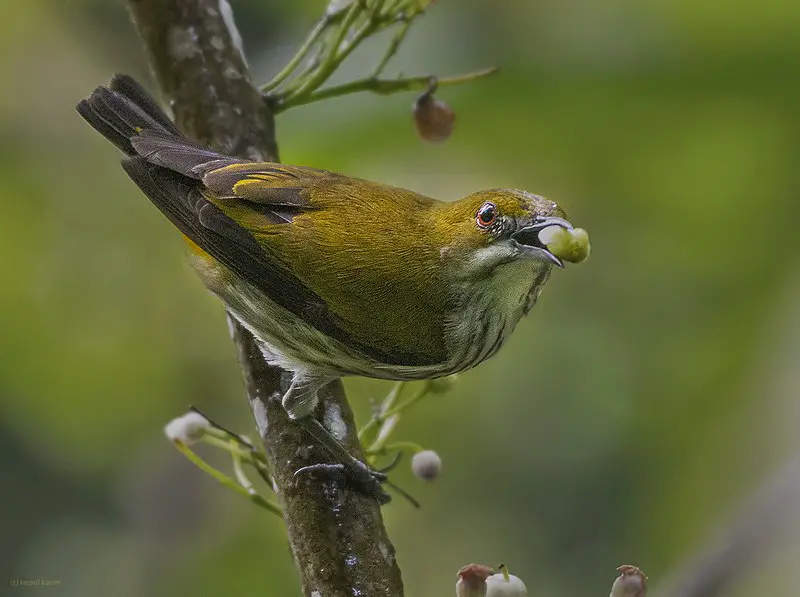
The Yellow-vented flowerpecker is a brightly colored bird belonging to the Dicaeidae family. It can be found in various countries across Southeast Asia, including Indonesia, Thailand, and Singapore.
This bird’s natural habitats are moist lowland and montane forests. They can often be found foraging for nectar and insects in the trees.
The yellow-vented flowerpecker shares some similarities with the D. melanoxanthum bird.
Its most notable physical feature is its bright yellow vent, which contrasts with its black head and greenish-yellow wings.
This small and stunning bird is a frequent visitor to gardens, and birdwatchers can easily spot it due to its distinctive features.Scientific classification:
| Kingdom | Animalia |
| Phylum | Chordata |
| Class | Aves |
| Order | Passeriformes |
| Family | Dicaeidae |
| Genus | Dicaeum |
| Species | D. chrysorrheum |
32. Scarlet-Backed Flowerpecker
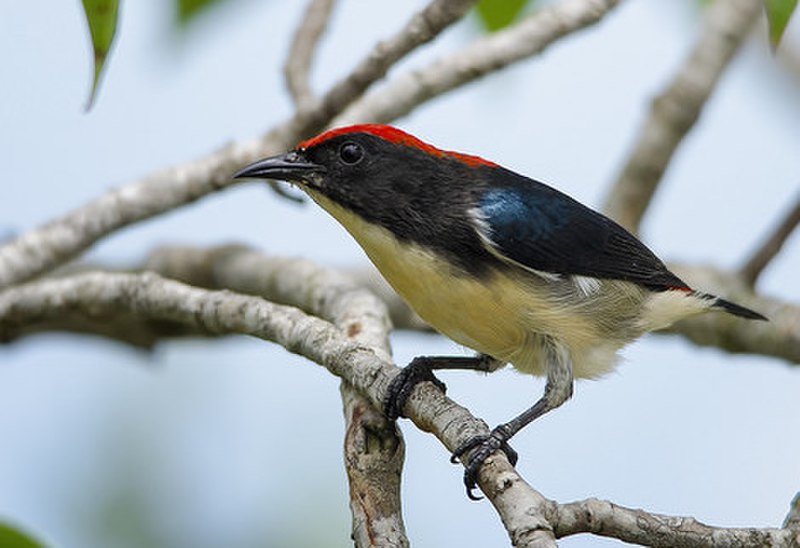
The Scarlet-backed flowerpecker bird is a passerine species that belongs to the Dicaeidae family. These birds are sexually dimorphic, meaning that males and females look different from each other.
The male has striking navy blue upperparts, and a red streak runs down from its crown to its tail coverts. On the other hand, females and juveniles are predominantly olive green.
Scarlet-backed flowerpeckers are commonly found in subtropical or tropical moist lowland forests and sometimes in gardens.
Their diet mainly comprises of nectar and insects. These birds are known for their active movements and can often be seen flitting through the forest canopy in search of food.
Scarlet-backed flowerpecker birds are fascinating creatures and attract bird watchers due to their distinctive colors and behaviors.Scientific classification:
| Kingdom | Animalia |
| Phylum | Chordata |
| Class | Aves |
| Order | Passeriformes |
| Family | Dicaeidae |
| Genus | Dicaeum |
| Species | D. cruentatum |
33. Golden-Bellied Gerygone
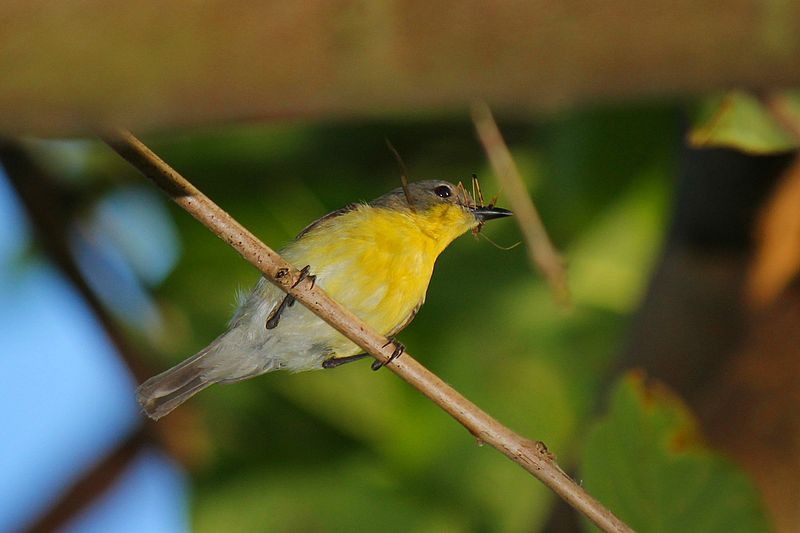
The Golden-bellied gerygone is a bird that belongs to the Acanthizidae family. This species can be found in Brunei, Indonesia, Malaysia, the Philippines, Singapore, and Thailand within lowland forests and mangrove forests.
Gerygone sulphurea is composed of different subspecies.Scientific classification:
| Kingdom | Animalia |
| Phylum | Chordata |
| Class | Aves |
| Order | Passeriformes |
| Family | Acanthizidae |
| Genus | Gerygone |
| Species | G. sulphurea |
34. Black-Winged Flycatcher-Shrike
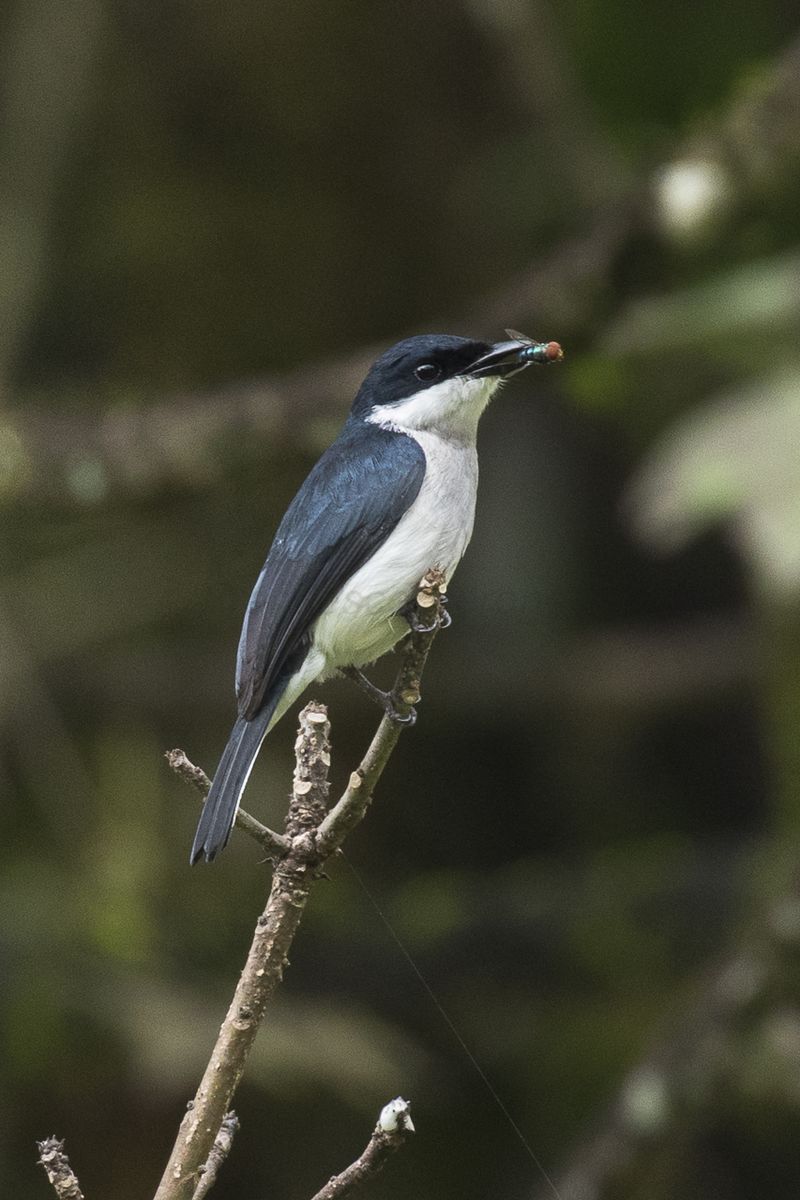
The Black-winged flycatcher-shrike is a bird species in the Hemipus genus, typically grouped with the Vangidae family.
Found in lowland forests and occasionally swamps or mangroves, this bird lives in the Malay Peninsula and Greater Sunda Islands.
Its sleek black wings make it easy to spot, while its small size allows it to maneuver through the trees with agility.
Despite its distinctive appearance, it is considered one of the least concerned species of bird according to the International Union for Conservation of Nature (IUCN).Scientific classification:
| Kingdom | Animalia |
| Phylum | Chordata |
| Class | Aves |
| Order | Passeriformes |
| Family | Vangidae |
| Genus | Hemipus |
| Species | H. hirundinaceus |
35. Crimson-Breasted Flowerpecker
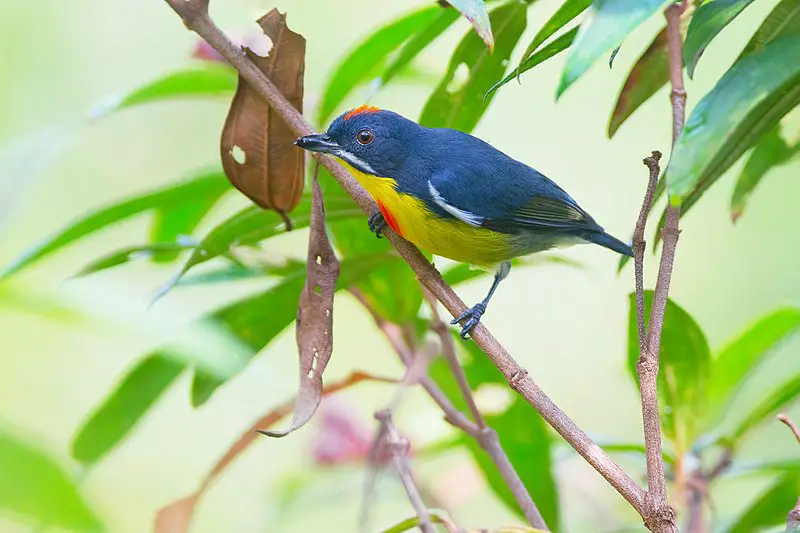
The Crimson-breasted flowerpecker is a beautiful bird that belongs to the Dicaeidae family. It is commonly found in various parts of Southeast Asia, including Indonesia, Malaysia, Myanmar, and Thailand.
This tiny bird has a bright red breast, black back, and green wings. It prefers to live in subtropical or tropical moist lowland forests and mangrove forests.
The Crimson-breasted flowerpecker is known for its love of nectar, and it feeds on flowers and fruits.
Despite its small size, it is an agile and active bird that can be seen flitting around the treetops. In addition, it has a chirpy, high-pitched call that can be heard from a distance.
Overall, the Crimson-breasted flowerpecker is a fascinating and beautiful bird that adds color and life to its natural habitat.Scientific classification:
| Kingdom | Animalia |
| Phylum | Chordata |
| Class | Aves |
| Order | Passeriformes |
| Family | Dicaeidae |
| Genus | Prionochilus |
| Species | P. percussus |
36. Large Woodshrike
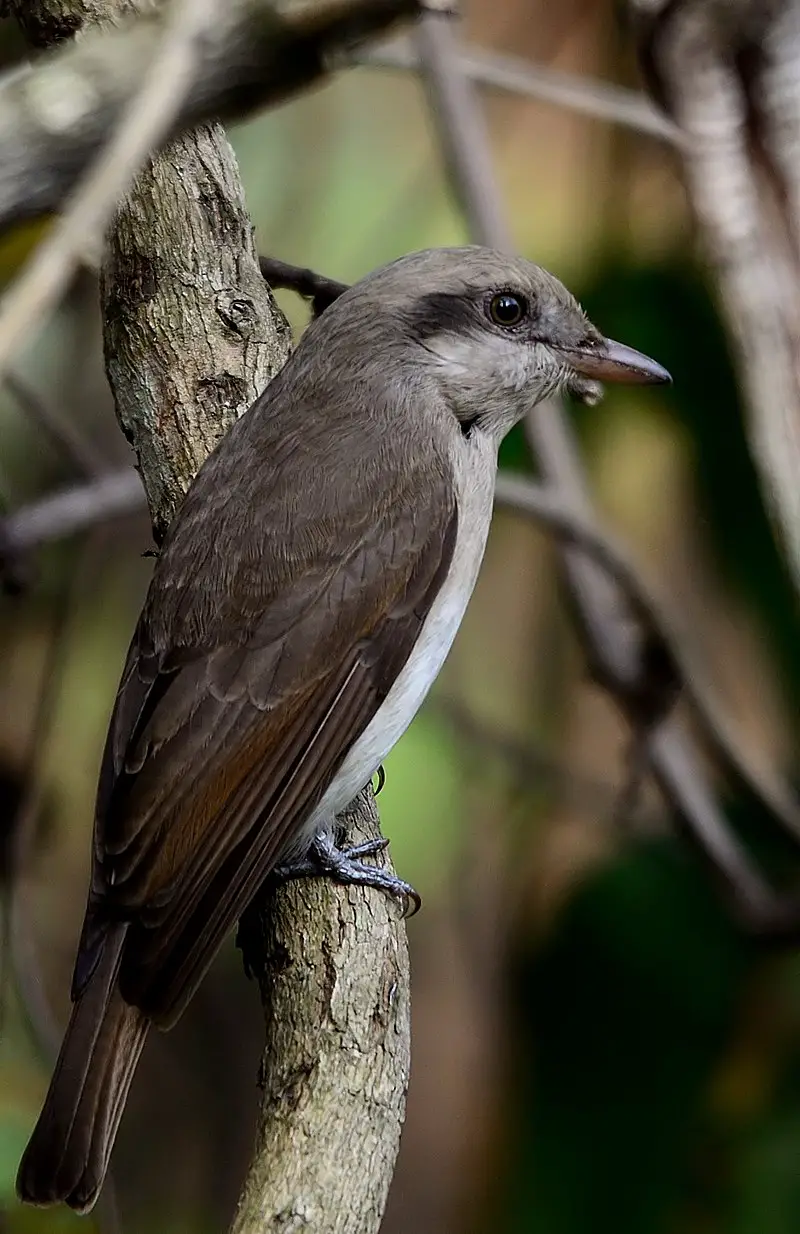
The Large woodshrike (Tephrodornis virgatus) can be found in south-eastern Asia, including Sumatra, Java, and Borneo.
This bird usually inhabits temperate forest, subtropical or tropical moist lowland forest, subtropical or tropical mangrove forest, and subtropical or tropical moist montane forest.
It belongs to the family Vangidae, and the Malabar woodshrike is sometimes considered to be the same species.
This bird is distinguishable by its large size, and it has a unique appearance with a black and white striped head and a rusty orange belly.
The Large woodshrike is known for its distinctive, loud, and melodious whistling calls that often last for several minutes.
This bird is also known for its cooperative breeding behavior, where multiple birds collectively help to care for and raise young chicks.Scientific classification:
| Kingdom | Animalia |
| Phylum | Chordata |
| Class | Aves |
| Order | Passeriformes |
| Family | Vangidae |
| Genus | Tephrodornis |
| Species | T. virgatus |
Also Featured In: Birds That You’ll See in Kaziranga National Park,
37. Buff-Necked Woodpecker
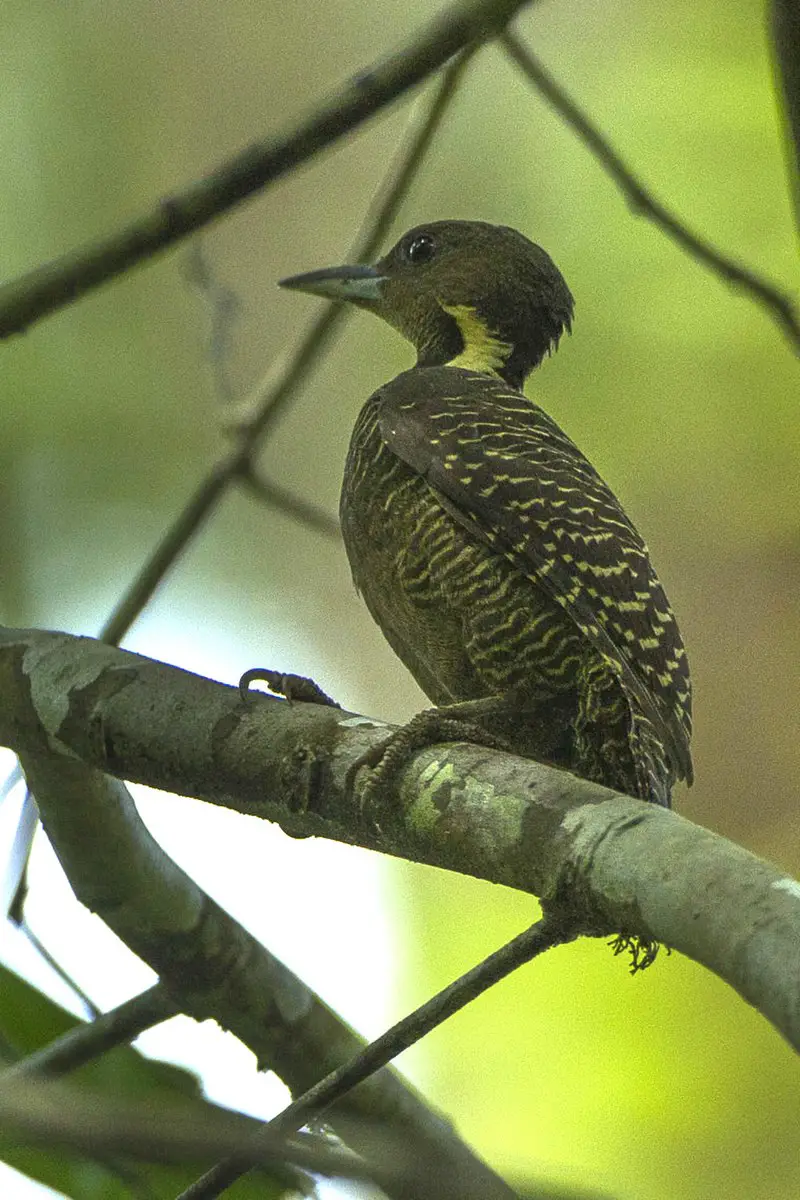
The buff-necked woodpecker, a member of the Picidae family, is a bird species found in subtropical or tropical moist lowland forests and swamps of several Southeast Asian countries.
Its scientific name is Meiglyptes tukki. Unfortunately, it is susceptible to habitat loss, which poses a significant threat to this species.
Therefore, conservation efforts can help ensure its survival for future generations to enjoy.
Despite its natural habitats being dwindled, the buff-necked woodpecker is a fascinating bird to observe with its unique appearance and behaviors.
Its distinct buff-colored neck and stout bill make it stand out among other birds.
Known for its drumming behavior, the buff-necked woodpecker often creates loud and steady sounds to communicate and mark its territory.
Overall, the buff-necked woodpecker is a bird worth studying that can provide valuable insights into the complex nature of the animal kingdom.Scientific classification:
| Kingdom | Animalia |
| Phylum | Chordata |
| Class | Aves |
| Order | Piciformes |
| Family | Picidae |
| Genus | Meiglyptes |
| Species | M. tukki |
38. Crimson-Winged Woodpecker
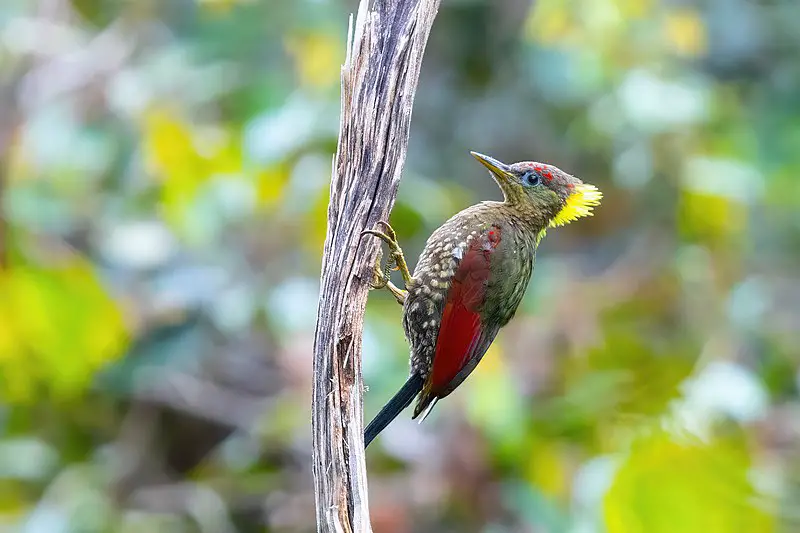
The Crimson-winged woodpecker is a vibrant and distinct bird species belonging to the woodpecker family.
This bird can be found in various regions of Asia, including Brunei, Indonesia, Malaysia, Myanmar, Singapore, and Thailand.
The Crimson-winged woodpecker prefers subtropical or tropical moist lowland forests as their natural habitat.
These woodpeckers can grow up to 25 cm long, and their diet is typically composed of insects and larvae.
Unlike other species of woodpecker, the Crimson-winged woodpecker is brightly coloured and visually striking, making it a sight to see.
Identifying this bird is relatively easy due to its vivid appearance, and it’s unlikely to be confused with any other species.Scientific classification:
| Kingdom | Animalia |
| Phylum | Chordata |
| Class | Aves |
| Order | Piciformes |
| Family | Picidae |
| Genus | Picus |
| Species | P. puniceus |
39. Black-Headed Bulbul
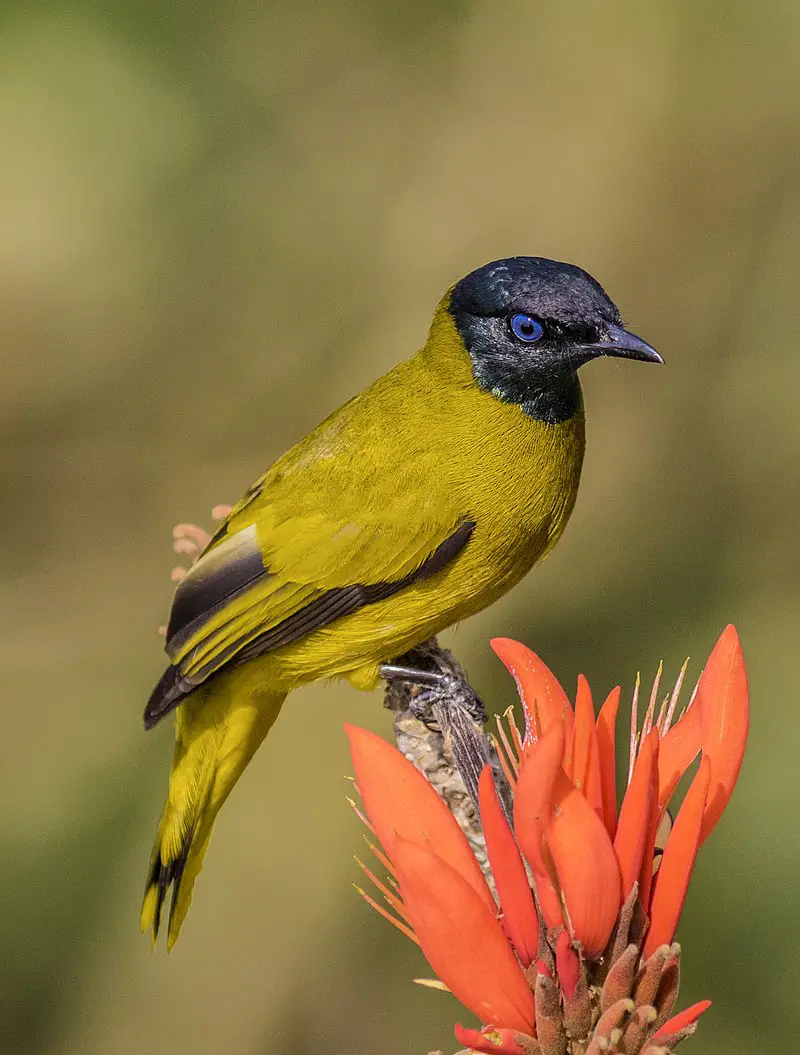
The black-headed bulbul is a bird belonging to the Pycnonotidae family. It can be found in forests across southeastern Asia.
Originally thought to be a member of the genus Turdus, it was later moved to Pycnonotus as Pycnonotus atriceps.
Recent research has shown that this genus is polyphyletic, leading to the creation of a new genus, Brachypodius, and the species being renamed Brachypodius melanocephalos.
This bird is easily recognizable due to its black head and yellow underparts. It feeds on fruit and insects, and is known for its sweet song.Scientific classification:
| Kingdom | Animalia |
| Phylum | Chordata |
| Class | Aves |
| Order | Passeriformes |
| Family | Pycnonotidae |
| Genus | Brachypodius |
| Species | B. melanocephalos |
Also Featured In: Native Birds Of Ko Chang District, Common Birds of Ko Lanta
40. Spectacled Bulbul
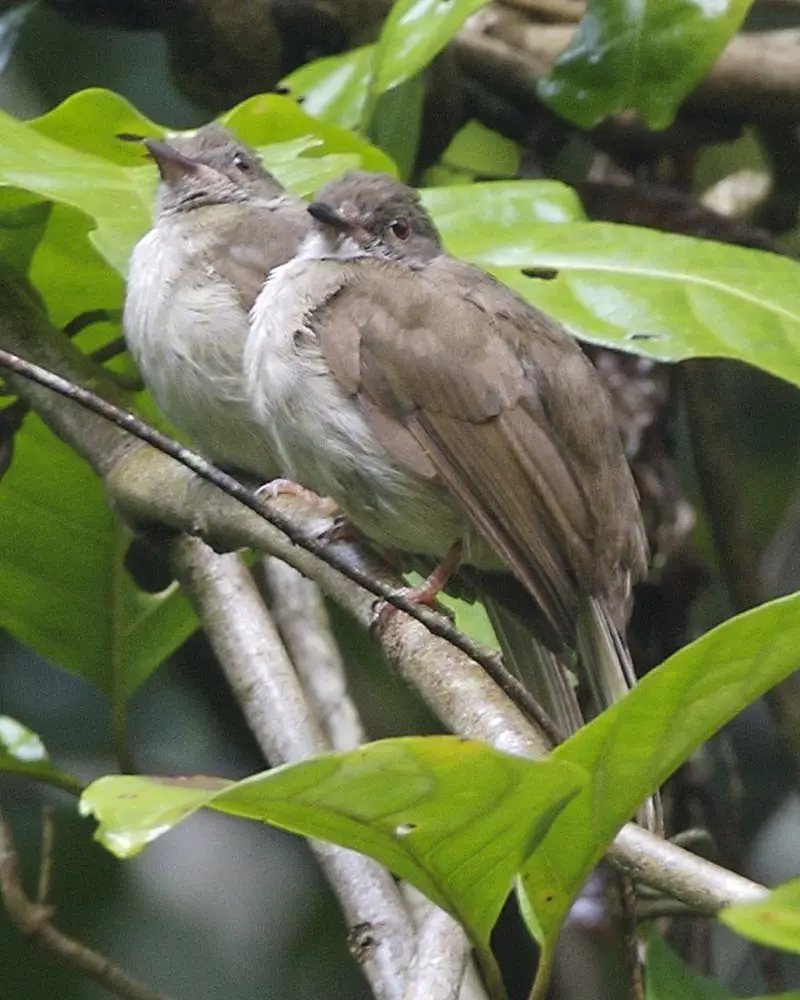
The Spectacled bulbul or Ixodia erythropthalmos, is a small passerine bird that belongs to the bulbul family. This bird is commonly found in the Malay Peninsula, Sumatra, and Borneo.
Ixos was the original genus where the Spectacled bulbul was first classified. Also known as the Lesser Brown bulbul, this bird sports an interesting feature of spectacled eyes.Scientific classification:
| Kingdom | Animalia |
| Phylum | Chordata |
| Class | Aves |
| Order | Passeriformes |
| Family | Pycnonotidae |
| Genus | Ixodia |
| Species | I. erythropthalmos |